
Posted in Costa Rica on March 22, 2023
Pre-Trip
The lead up to departure included several Google Meets meetings with all of the participants from Salesforce.com and any friends or spouses joining them, Joy Demsey from DWC, and me. We met every two weeks for about an hour to exchange information, packing tips, plans for the work, logistics, etc.
It became apparent to me right away that this was a very young (compared to me), energetic, and diverse group of volunteers. Though most seemed to physically work for Salesforce.com in the Toronto or Vancouver areas, many were teleworking and only a few held Canadian passports. The team hailed originally from India, Pakistan, Syria, France, and Canada. I didn’t check ages, but it seemed that all were well under 40 with most in the mid- to late-20s.
Communication was excellent throughout the process as we set up a variety of WhatsApp groups: one for team leadership, one for the entire group, and smaller ones for each wave of volunteers arriving in San Jose together.
One couple arrived a week early and was on the ground for vacation sending photos, videos, and recommendations to the team.
I was looking forward to seeing the campsite again, as well as reconnecting with our work supervisor, Carlos, our overall in-country lead, Marco, and then meeting our new on-site lead and translator, Mariné. Conchita was not in Costa Rica this time, but she stayed involved through messaging. She also arranged for a local special dinner for the whole group that would take place on Thursday, 23 March in Siquirres.
For the trip, I tried to pack very lightly, expecting to do some sink and shower laundry during the trip. I was also carrying with me several T-shirts to donate to the locals at the work site, as well as a fresh pair of rubber boots. Diana, the local national park ranger that had done such an excellent job translating for us with the local during our previous stay, had asked if I could bring along a new pair of work boots for her, too, so that added to my inbound weight.
Friday 17 March 2023
I left snowy Colorado Springs just after noon on St Patrick’s Day, flying on United via Houston International where I was able to get an early dinner at the United lounge here. The flights were smooth and uneventful, and I arrived a few minutes early to SJO at 8:50pm.
During the day, I’d been in near constant email contact with Stacey, the guest services manager at the Hotel Irazu in San Jose, who assured me that all would go smoothly—I would meet someone with a sign showing my name outside of the Malinche Restaurant at the airport’s exit and be whisked away quickly to the hotel.
Of course, that did not happen. There was no sign with my name, just dozens of taxi drivers telling me that the Hotel Irazu no longer had a shuttle, but that they would gladly take me there for only $30US. After pacing the exit area twice searching for my name, and unsuccessfully trying to call the hotel (another issue that wasn’t solved until the next day with my phone) I finally found a guy holding a Hotel Irazu page up in his three-ring binder of taxis and tours. We communicated haltingly and he called the hotel. Somewhere there apparently confirmed that transportation was forthcoming, but he told me that it would be 20 to 30 minutes. I waited around, trying to avoid other taxi drivers who continued to badger me with offers.
Finally, at about 9:45pm, the gentleman with the Irazu sign led me to the nearby parking garage where a red taxi driver loaded my bags into the trunk and said we were going to the Hotel Irazu.
The 20-minute drive passed quickly but when we arrived, expecting to be dropped at the main entrance to the hotel complex, I was to take to a side door which, my driver assured me, was the Hotel Irazu.
When we were in Costa Rica last June, we stayed in the same location—a rather bizarre hybrid hotel. On the south side and containing the main lobby and most of the amenities was the Best Western San Jose. The north side had a wing of what looked like two- to three-star accommodations. Both seemed to share the pool, but had different breakfast areas. We enjoyed the Best Western and their front desk was helpful, their breakfasts excellent. The Hotel Irazu wing, last summer, seemed to be where large school and visiting athletic groups stayed on a budget. It was not nearly as neat, clean, and quiet.
The entrance where I was dropped, it turns out, was to the hotel Irazu. The Best Western has now become a Holiday Inn and included upgrades like a new sports bar and grill at the entrance which we had seen in mid-construction last summer.
The Irazu entrance looked like we were headed to the workers’ quarters, frankly—down a hidden staircase into a rather industrial looking lobby/reception.
As I checked in, my taxi driver haggled with the front desk for payment. I stayed out of it completely, never intimating that I had any responsibility to pay. Once resolved, they got to my room and the nice young lady finally handed me a key.
I went to the room, but the electronic key wouldn’t open the door. I returned and asked for help. She accompanied me back to the room and tried the key. This time it worked, but as she tried to open the door, the safety latch caught and someone insides yelled (in English? “Who’s there!” The room was occupied. The desk agent asked the occupants name (Lucas) and then said that the room was supposed to be empty. It clearly wasn’t. We returned to the desk.
She gave me a new key to the room next door to Mr Lucas and I was finally settled. By now, though, I couldn’t get to sleep from hauling my three bags back and forth to the front desk twice, so I read a little more, sent a few messages and finally dozed off just before midnight.
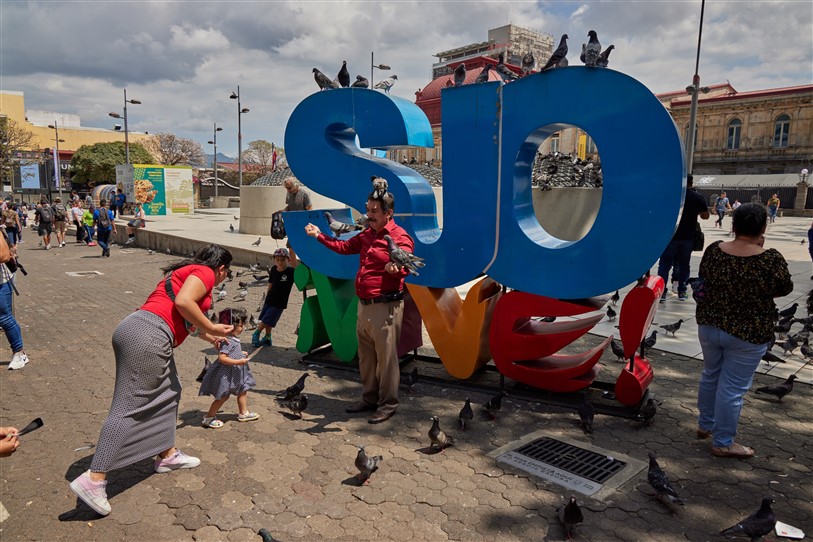
Saturday 18 March 2023
On cue, I woke up at 0530. I tried to sleep a little longer, but the anticipation of the day prevented that. A little after 6am, I put on my workout gear and headed to breakfast. The Irazu breakfast is not nearly as good as the one offered by the Best Western last summer and probably by the Holiday Inn today. It was on a terrace at the far end of the pool and didn’t have offerings like yogurt or more than a couple of fresh fruits (papaya and watermelon). The coffee was as good as always, though. I focused on that and the fruit, with a little bit of cheese.
The weather was beautiful. Not a cloud in the sky, refreshingly cool and no breeze. After breakfast, I walked over to the Gold’s Gym that has an arrangement for gym services with the Irazu, but discovered that it didn’t open until 8am. So, I returned to the room to write.
Just before 8am, I went to the gym and put in 45 minutes on a recumbent bike along with some push-ups and planks. At about 9am, I returned to the front desk to check on Prashant’s ride from the airport. He’d text me that he had arrived in San Salvador and was boarding his flight to San Jose on-time for a 9:25am arrival. Records indicated that he was on Avianca flight 529, so I confirmed this with the front desk.
They assured me that someone would be there to pick him up, but that there was no flight 529 arriving into San Jose today. I frantically searched my records, but could find no other info on Prashant’s flight. My records didn’t have his PDF flight receipt—I just had the number on the consolidated spreadsheet.
I assured them that he would be at the airport at 09:30am nonetheless and then started my own research back in my room—but then my room key didn’t work again!
I returned to the front desk and got a new key, clarifying for the third time that I was staying for two nights with the DWC contract and group.
Back in my room, I discovered that he had taken flight 529 to San Salvador, but was due to arrive on AV 639 into San Jose. I informed the front desk and they once again assured me that all was good.
Back in my room now, I showered, told the cleaning staff to not make up my room, and then waited and monitored Prashant’s situation.
At 09:56 he texted me that there was a taxi driver with his name (misspelled) and I told him to get in, making sure the driver was headed to the Hotel Irazu.
Prashant stashed his bags in my room since his room wouldn’t be ready until 2pm and I ordered an Uber to take us to Mercado Centrale in downtown San Jose. We arrived there without any trouble and started walking the streets in the pedestrian area. It was crowded and all of the shops seemed busy on this late Saturday morning. The weather was clear and relatively cool.
I thought that we were walking east towards the government buildings, national museum, and central park area, but realized that I was turned around a little too late. Instead, we’d walked the length of the main drag and arrived at the old airport and art museum.
By the time we arrived, we were ready for lunch. I asked Prashant what he’d like for lunch and he said he preferred to eat something local. Luckily, as we looked to our left, we saw a “Soda,” Costa Rican for local fast casual street food. Prashant ordered the Arroz con Pollo and I had the grilled fish lunch plate. Each of us had a fruit juice—papaya for me, banana for Prashant. The food was good and exactly what we’d experienced on our previous trip.

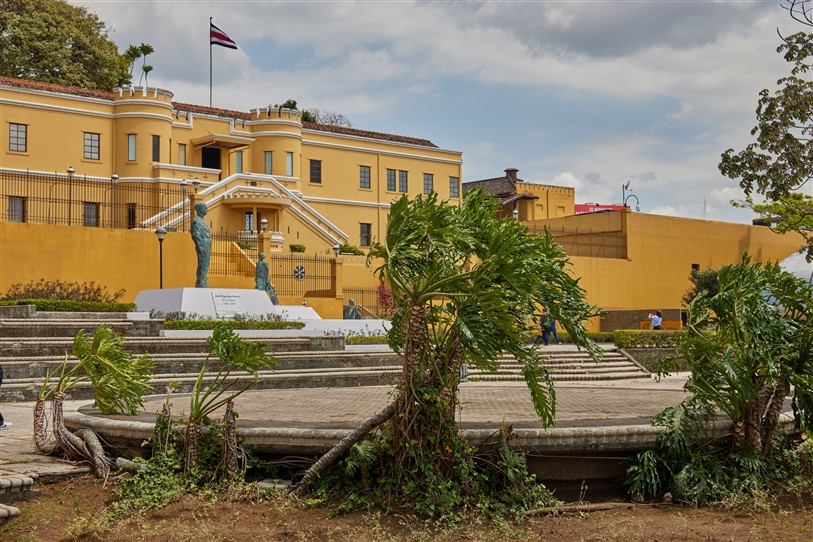

I learned that Prashant was from Lucknow, India in Uttar Pradesh (UP). He lived in Orange County, California, working remotely for Salesforce after doing his master’s in computer engineering from NYU. He hadn’t traveled very much in the US and had, in fact, been “stuck” in the US for almost four years due to CoVID, unable to return home to visit family. He’d just returned from his first trip back to India in four years, but while he was in India had worked remotely, usually from 7:30pm local time in Lucknow until 3:30am.
After lunch, I decided to order another Uber to take us across town to the Parc Nacional. There, we found a large festival occurring in the park with a big stage set up in the middle and a popular local band playing. There were merchants with tents set up and street performers hula-hooping, dancing, and climbing ropes into the trees.
From there, we walked back into the center of town, passing by the Supreme Court, national legislature, and national museum. The streets were even more crowded than earlier.
At about 2pm, I ordered another Uber and we returned to the Hotel Irazu to check-in. There was considerable confusion now as the front desk thought that I only had a reservation for one night and, moreover, had to move out of my double room they’d originally given me into a single. No big deal.
They also didn’t have a list of who was staying in what room when the other seven would arrive later. I tracked that down with Joy’s help and completed the registration forms for everyone so that check-in would be very quick that evening. Prashant got his room and I moved across the hall to my single.
We decided to just meet for dinner when the rest of the group arrived that evening. I tracked their flight on Air Canada from Toronto via the internet and saw that they were scheduled to arrive about a half-hour early. I alerted the front desk so that transportation would be waiting for them earlier and just relaxed, read, wrote, and did some calisthenics.
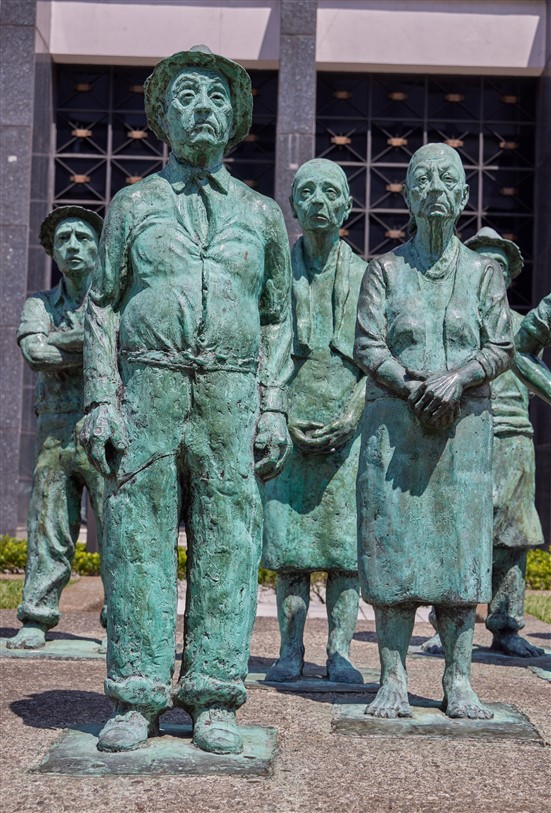
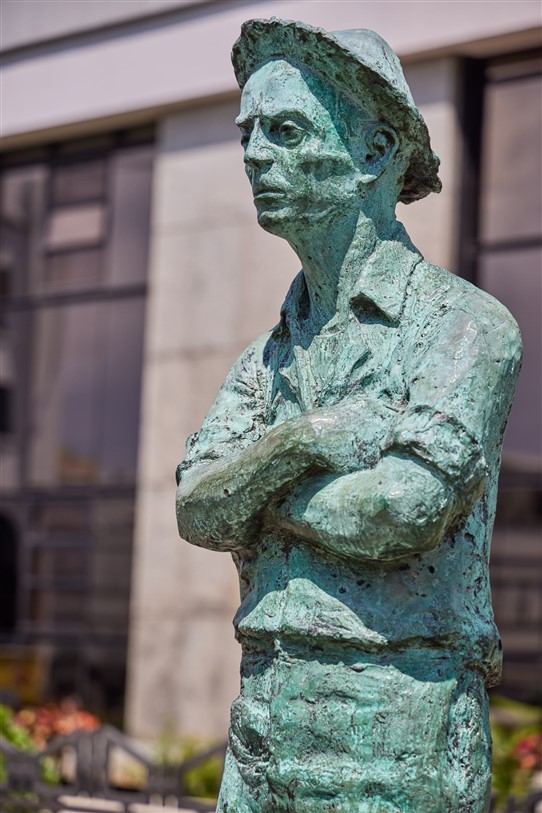
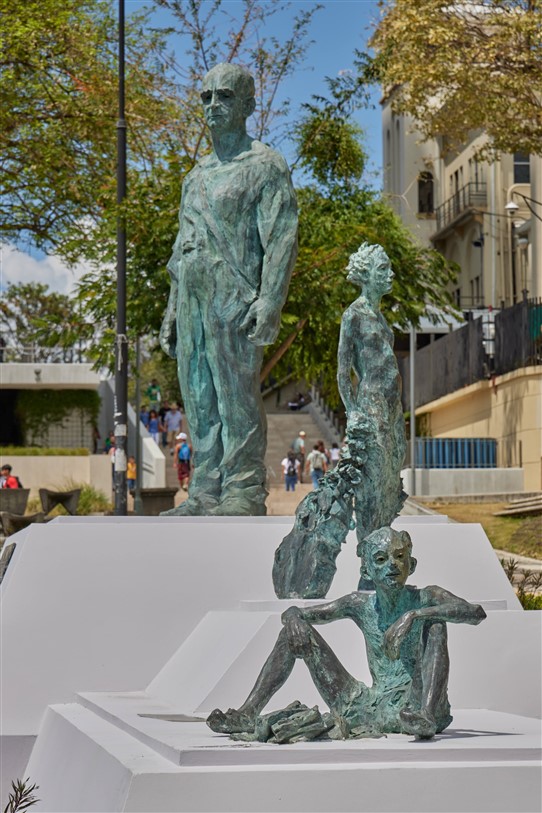
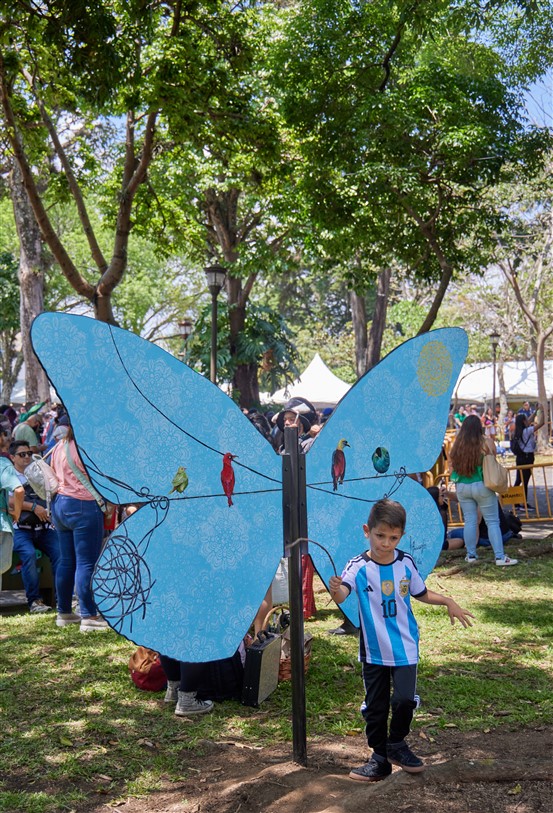
The team found their transportation after passing through a very long immigration line and collecting their bags. They arrived at the Hotel Irazu just after 9pm and after dropping bags in their rooms met us at the newly completed Holiday Inn bar and restaurant.
They were all very excited and peppered me with questions. I’ve been asked at least 100 times now what our specific tasks will be at the work site and given the same answer every time: We think we will be building a campsite tent platform and shelter, but will be doing lots of other work to include digging a pit for another septic system, but that we never really know until we get there. I always assure them that Carlos will have a plan and that we’ll have plenty of work. Otherwise, the conversation centered on everyone getting to know each other.
The team ordered plenty of food and a few ordered beers. I decided to pass on beer that night and just had a Caesar salad. I reiterated several times that we would be leaving no later than 7:30 am the next day and that breakfast started at 6 am.
I went back to the room and went to sleep quickly. I’d already repacked during the waiting time for their flights.
19 March 2023
Of course, I woke up before my alarm. I wrote a little, checked email and then went to breakfast at about 6:30am taking my laptop with me to write some more. No one else arrived to the breakfast area before 7am when Zohaib and Deepak walked in, followed by Mitchell and Daniel. At about 7:15, I found our driver, Sherman, parked near the exit and told him that we’d be ready by 7:30. He had a large silver tourist van with seats for 12.
The team straggled into breakfast slowly. I didn’t think that they would be ready to leave at 7, but almost all of them were there with seconds to spare. Prashant and Karthik were the last to arrive, the latter almost 10 minutes late. We decided that the last one on the bus would be responsible for the first round of drinks that night and Karthik was a good sport about it.
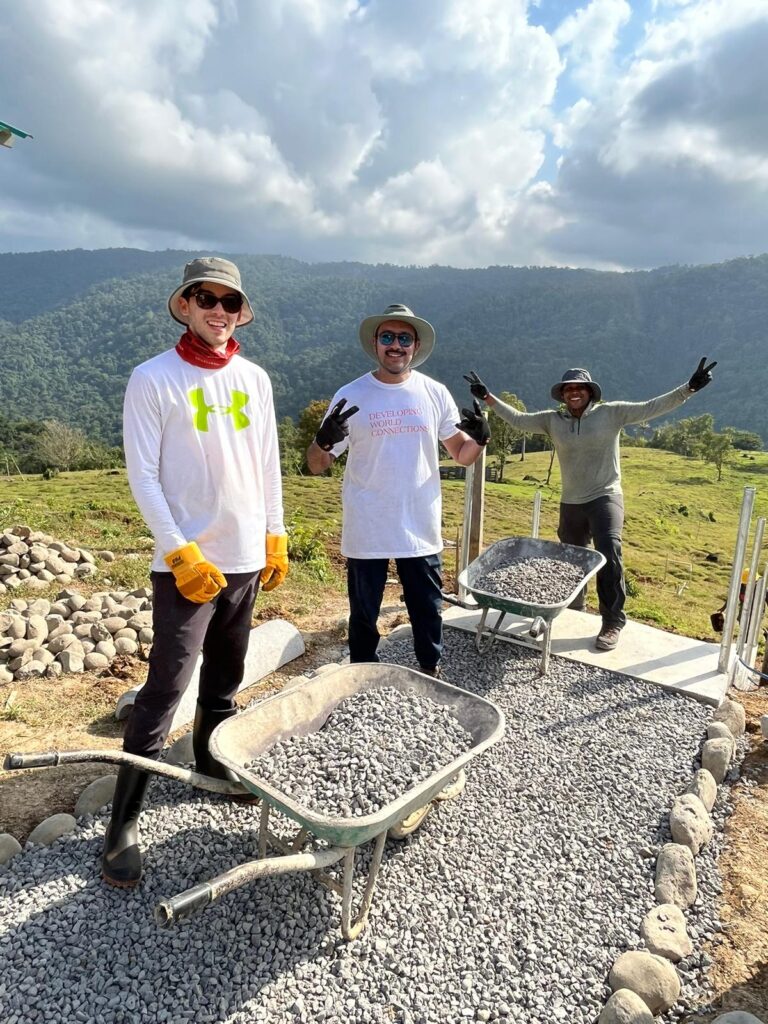
Monday March 20
Day 1 for DWC’s “2023 Team 3” of Salesforce.com employees and friends dawned with clear skies and high expectations. I was pleased to see Carlos, our foreman, again and we had enjoyed working with him so much during the earlier trip I led–DWC’s first post-CoVID trip–to the same site last June. Then, the campsite in Tsinikicha had consisted of the large thatch-roofed circle room and one camping tent platform. We had added pathways and a bathroom. with two stalls and a shower over our two weeks of very rainy work.
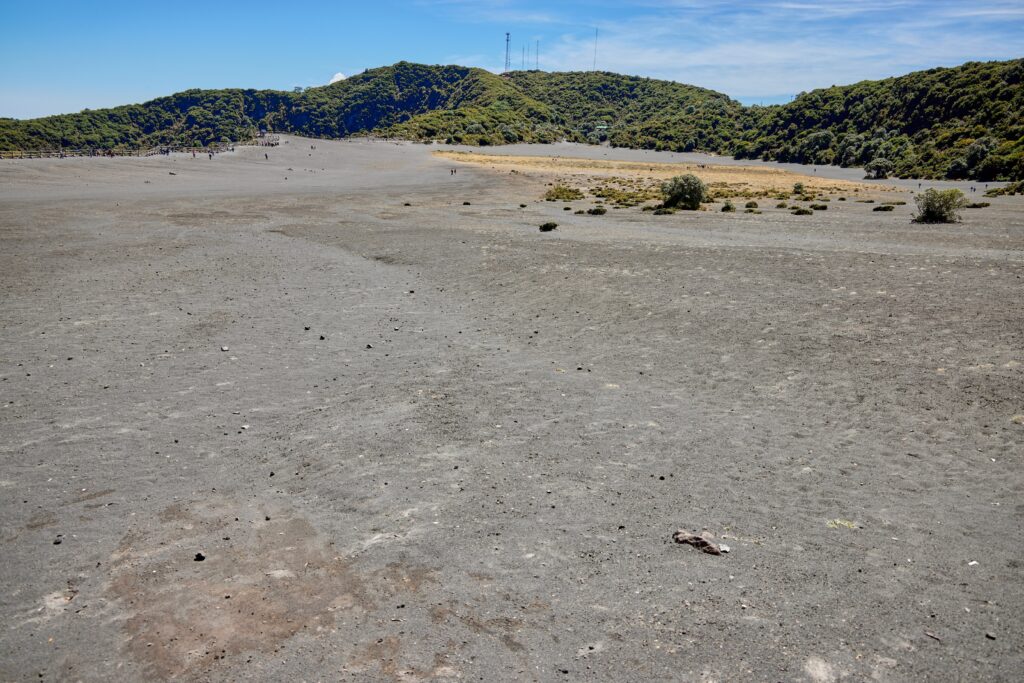
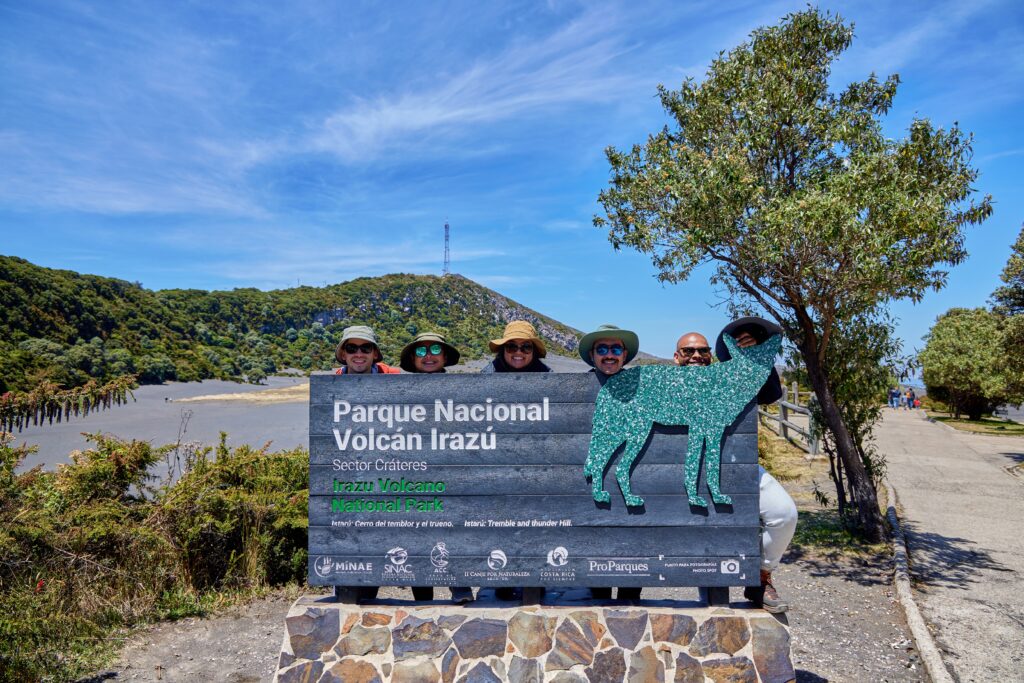

Our team this year was much bigger (15) and younger. The oldest (besides me) on the team is. The oldest is “only” 39 and most just are 10 or more years younger than him (Deepak). We began with introductions at the van and were on our way by 7:40 for the 35 minutes of bumpy ride into the mountains and the work site.
Spirits we’re high along the way. We had a great view of the Torrealba Volcano and our driver, Vicente, even stopped the van once to show us a pair of green toucans in a tree, as well as some green “parriquitos.”
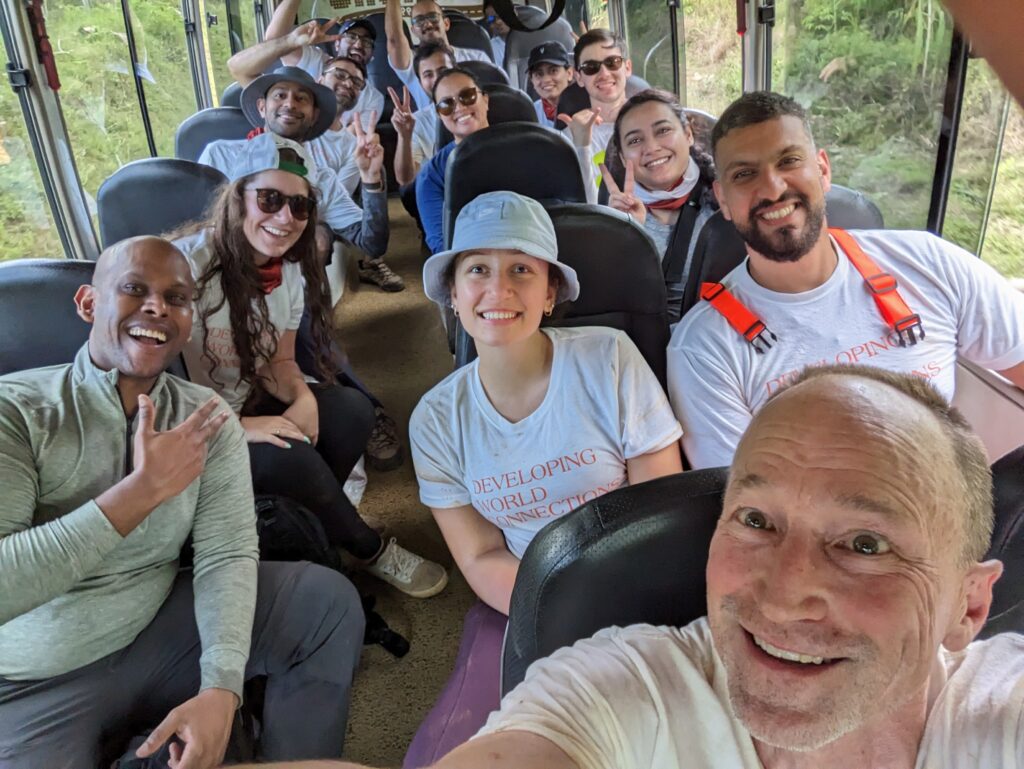
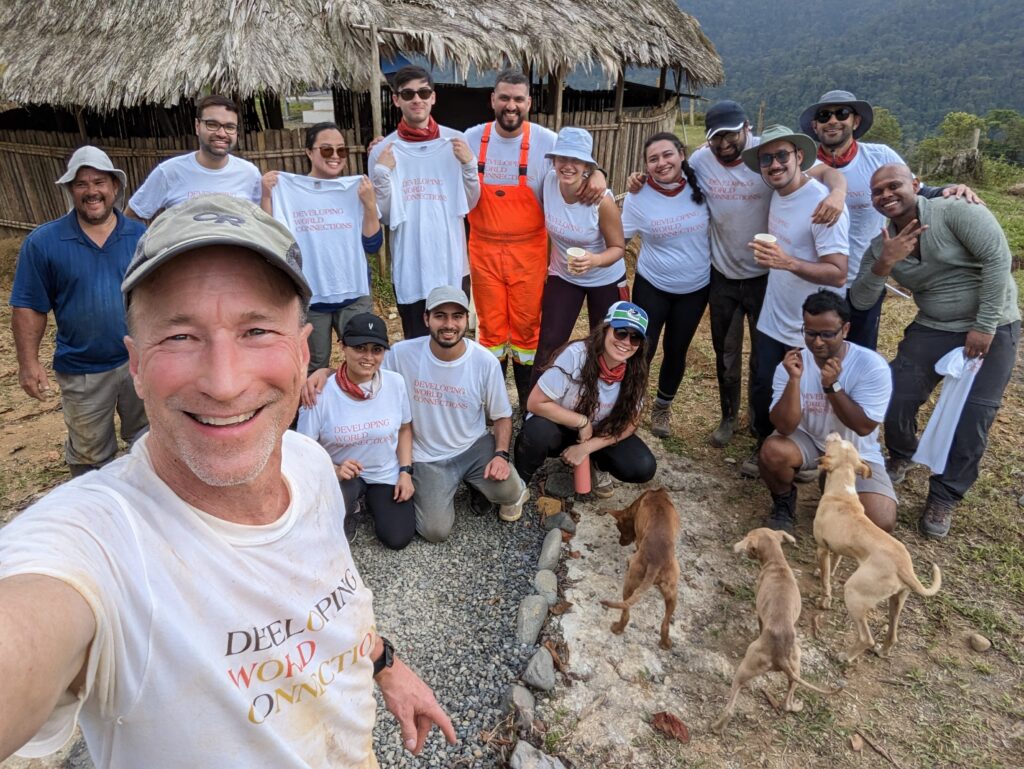
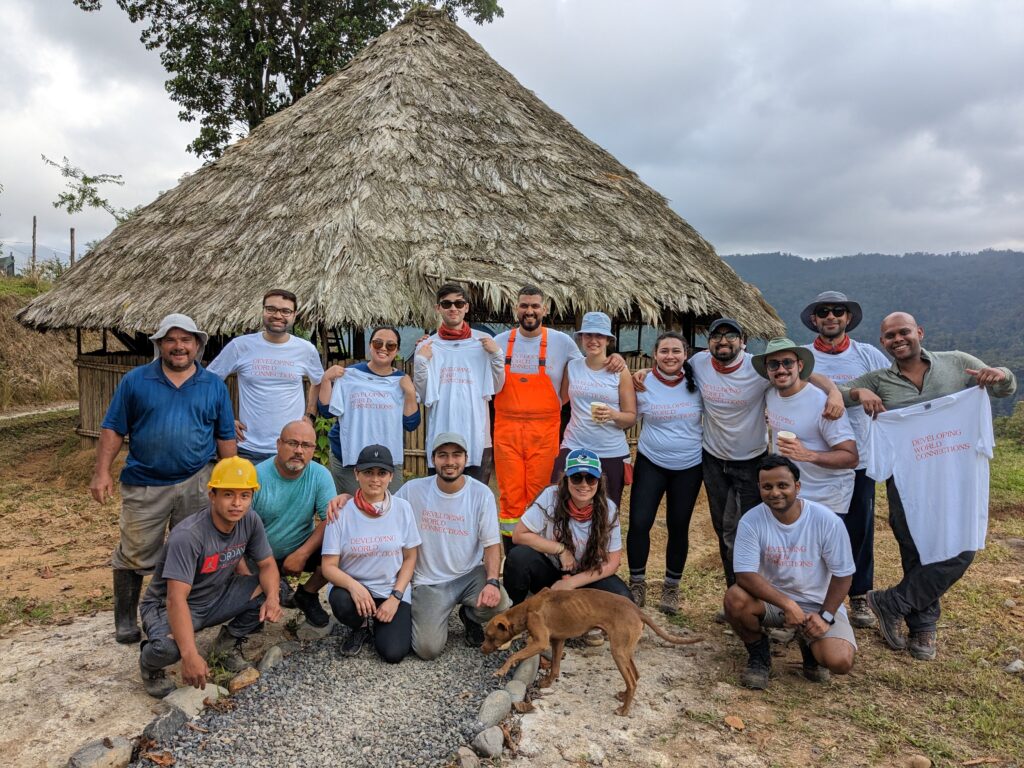

When we arrived at the site, we unloaded some of our equipment at the recently built kitchen area–just north of our bathrooms–and left some in the van.
We met our local translator, Mariné, and she told us about herself. She’d come to Costa Rica from Sweden 30 years and stayed. A trained anthropologist, she has worked with local, indigenous communities like the Cabecar of the Tsinikicha village since then. She even worked to document and preserve their native language. Her English was nearly flawless and we could all see that she was not only deeply committed to the community, but also very happy to be working with us.
I gave a safety briefing to start–mixing in a little philosophy of DWC work–and then we split into groups at Carlos’s request. Our primary tasks this day would be to haul some gravel into a pathway that led to concrete steps down the hillside finished by Carlos and others the week prior, to dig and reinforce about an 80 meter drainage ditch leading from the upper camping area into the pastures below, and to begin work on a new tent camping platform about 10 meters in elevation below the main camping area.


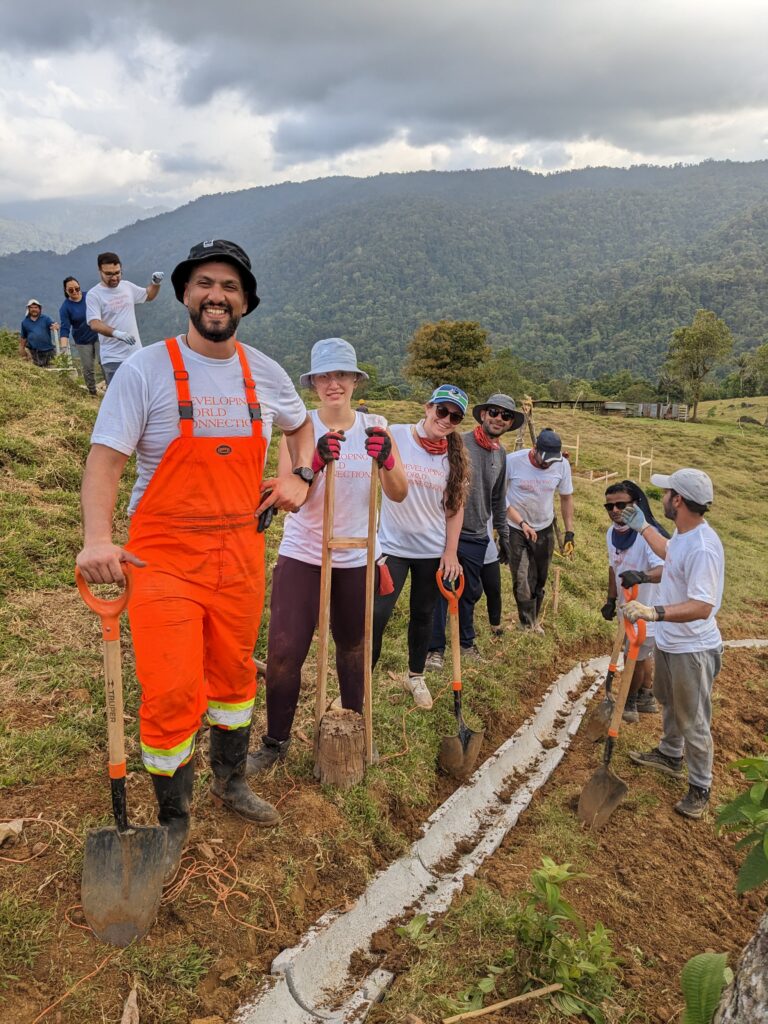
Hélène took the lead on the ditch work as her Spanish skills paid off quickly. Carlos staked out the path she and her team would follow.
Another team grabbed wheelbarrows and made quick work of the pathway described above.
Tarek and others joined Carlos and Hugo (a local with whom we’d worked last time) and they started staking and leveling the platform area.
Hugo brought one of the concrete half-pipe drainage conduit pieces to Hélène’s team and Carlos showed them how to put it in place. Teams worked on and off digging the grainage path throughout the day. We had 30 sections of half-pipe, each two meters long, weighing about 40 kg each. The key here was to dig deep and wide enough to fit each piece more or less flush with the surrounding ground.
Carlos took a break from the platform marking to show a team how to build the steel reinforced frame for each concrete platform pedestal. I cut the quarter- and half-inch rebar into proper lengths and then we bent pieces using a mandrill designed by Carlos on the fly.
From there, Carlos showed Mitchell, Kellie, and Akash how to assemble the pieces into one meter long square steel columns. It was tedious work, but they completed three of the columns by the end of the day–allnto Carlos’s quality standards.
We took a snack break at about 10am that includes juice and coffee. Several commented on how hard, but fun the work was. I reiterated the importance of short breaks and hydration in the hot sun.
After the break, work on the drainage area picked up. Hélène, Hana and their crew set the first group of pipe sections before our first sharp turn and Carlos explained that he would use concrete to complete the bend. From there, they started the large run to the top of the hill, with 10 or more digging at a time.
At the platform, we found “level” at each of four corners using a clear plastic hose filled with water to set the same height–itb was ingenious. Then Carlos, Hugo, Vicente, and Tarek marked the corners and set it all square. The two diagonal measurement matched to within less than a centimeter, as did all four side lengths.
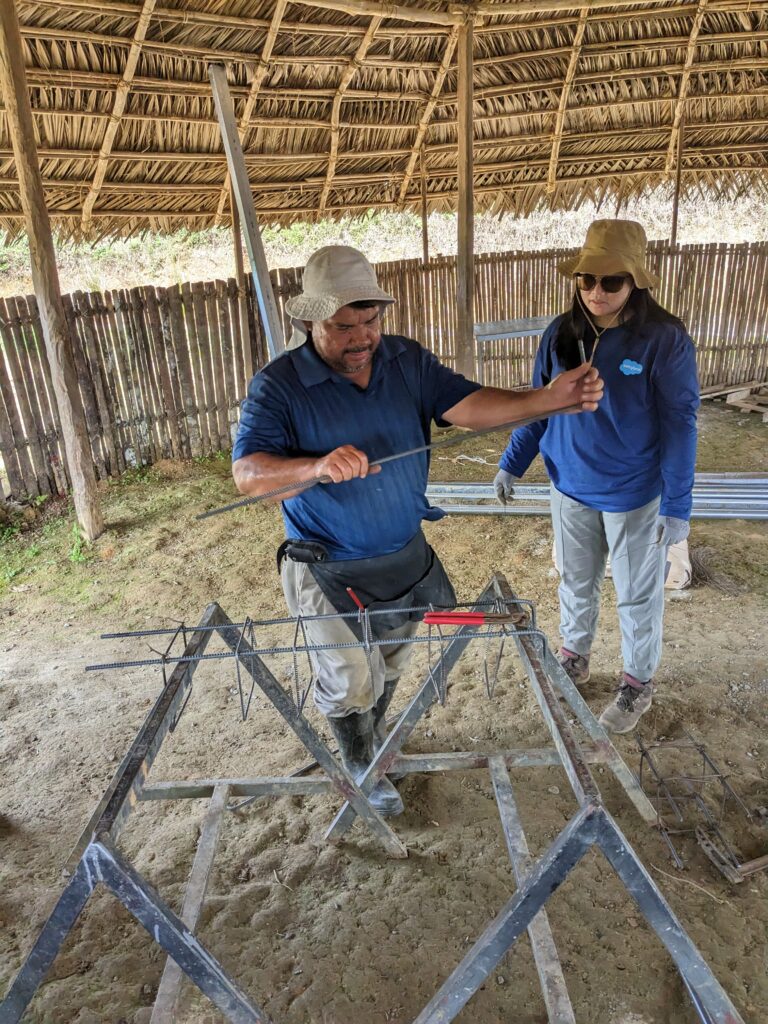
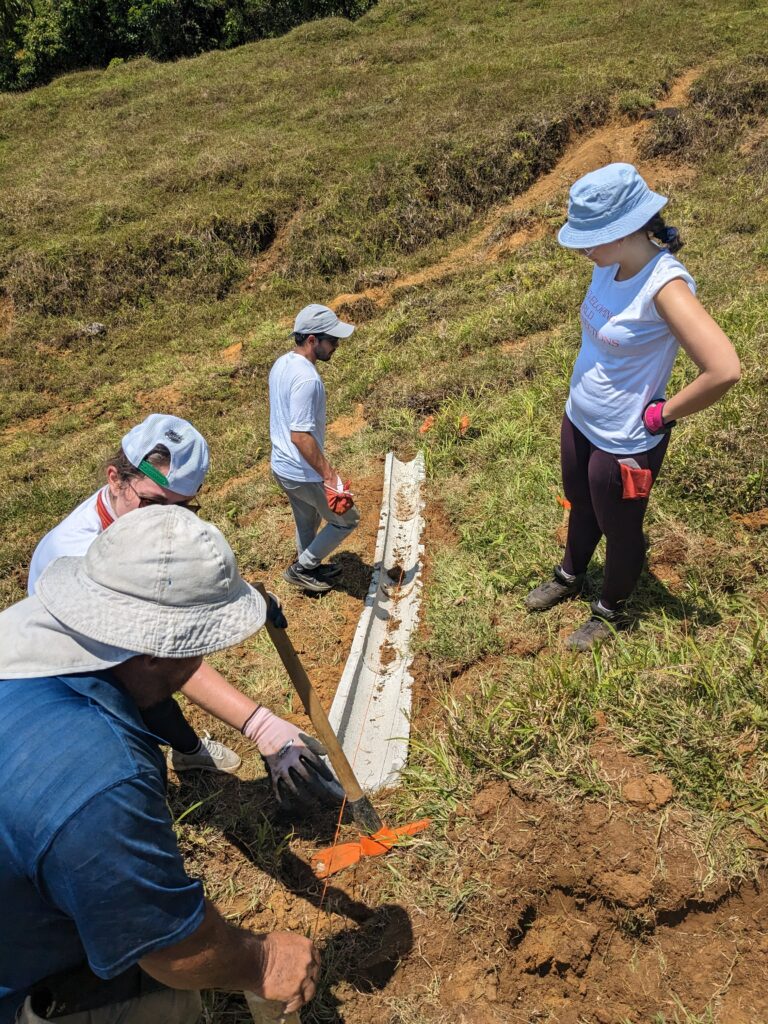
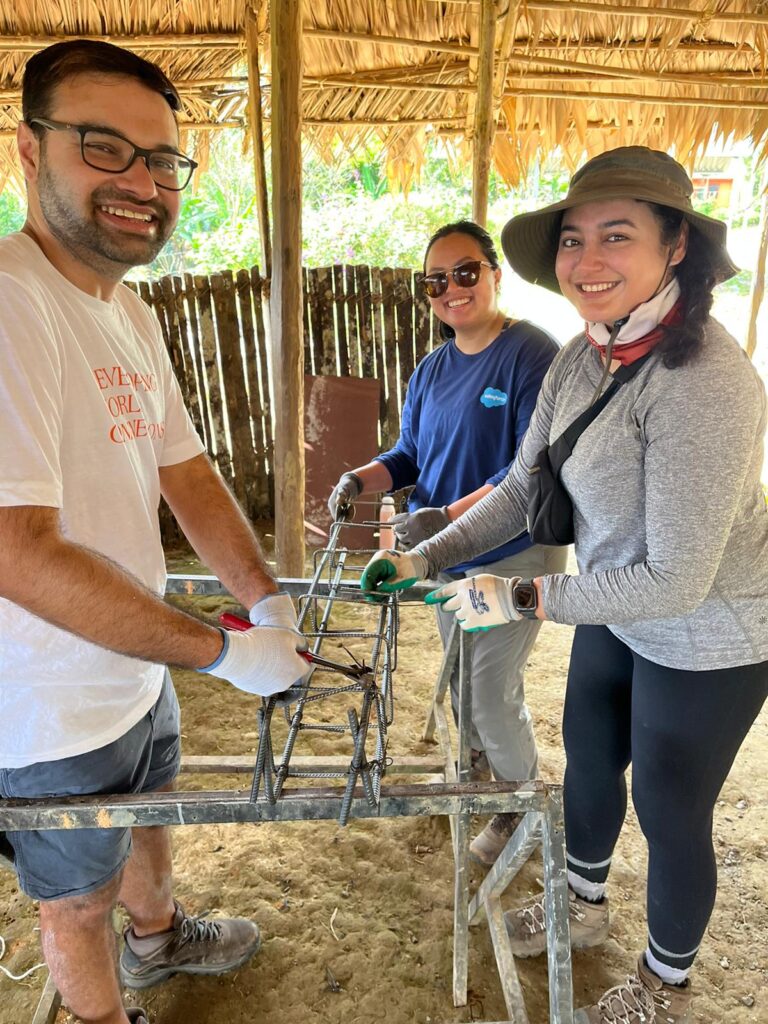
Mariné called us to lunch at 12:30 and we’re all ready for the break. We walked to the wooden community center house where one of the local women served us rice, beans, squash, and chicken as well as tamarind tea and a tropical fruit juice.
We heard the team back to the worksite before 1:30 and all decided that we should complete the drainage path before day’s end.
By 2:30, the drainage work was moving very quickly–probably too quickly, as several took breaks to cool down and recover. I felt like I was working as hard as I ever had on a project, recognized some of the first signs of heat exhaustion, and laid down in athe shade of a camping platform to recover for a few minutes.
After our next break, several worked to move the remaining pipe sections closer to the work area, move back of cement mix to the thatch ring for cover, and carry down square concrete blocks to the platform construction area for later use within and under the pedestals. These jobs don’t just involve digging–there’s a LOT of hauling and transporting, too!
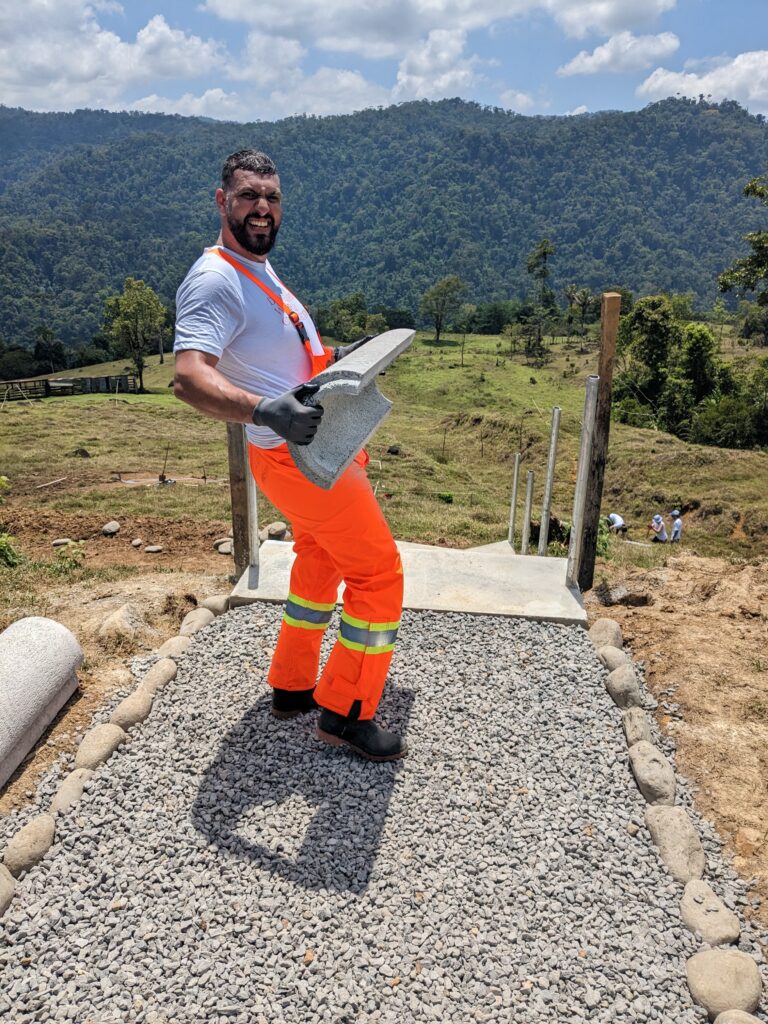


By day’s end, we accomplished more than I think any expected. We had installed all 30 of the two-meter pipe sections, but needed to wait to finish the work until another dozen could be delivered. Carlos had installed concrete along the seams and turn-gaps in the pipe to seal the flow, three columns were assembled, the upper gravel path was done and Tarek, Carlos, and team had begun digging the holes that we would fill with square concrete block, rebar frame, and concrete to form the pedestals of the platform.
We decided to call it a day–a very successful day–and Carlos told me the plan for the next day.
On Tuesday, the plan would be to finish the fourth rebar column and pedestal excavation. From there, we could mix concrete and pour the pedestals that would then have a day to set and cure before we attached and welded the supporting corner columns, hopefully on Wednesday.
We would finish the drainage path, too, but the primary tasks would be to move gravel to the lower path after setting the path border by setting large, round, white river rock into the ground. That would mean hawling several tonnes of gravel and rock. Carlos asked me to assemble a team of the strongest to do that.
The ride back to the hotel saw a little bit of rain. The group was tired but quite animated and vocal; happy with all they’d accomplished and comparing and sharing photos and selfies of our work.
We decided to call go to the local MaxiPali (Walmart) on the return to buy some supplies. That worked out well because Vicente need to go there anyway to buy more water for Tuesday.
Some bought sunscreen, lotion, a few snacks, sponges for scraping dirt from our skin in the showers, and even a bottle of Johnny Walker Red.
We returned to the hotel at 5:45pm and resolved to meet in an hour for the walk to dinner at the Soda West restaurant about 200 meters away.
Most arrived on time and just before 7:00 we walked over in the darkness.
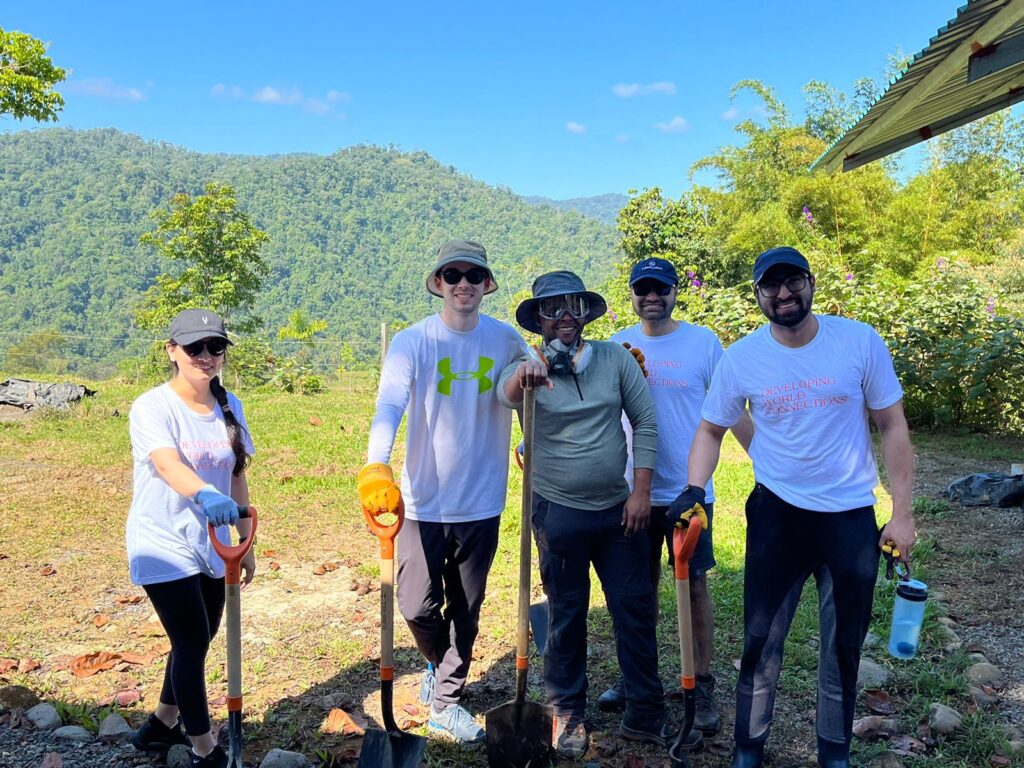
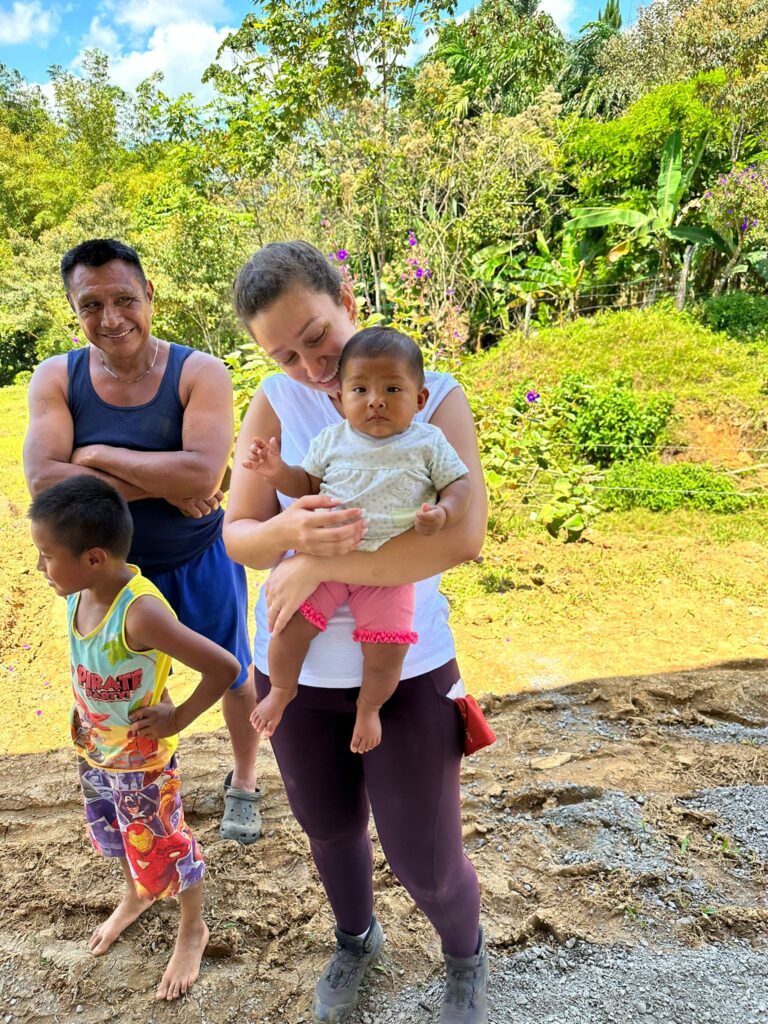
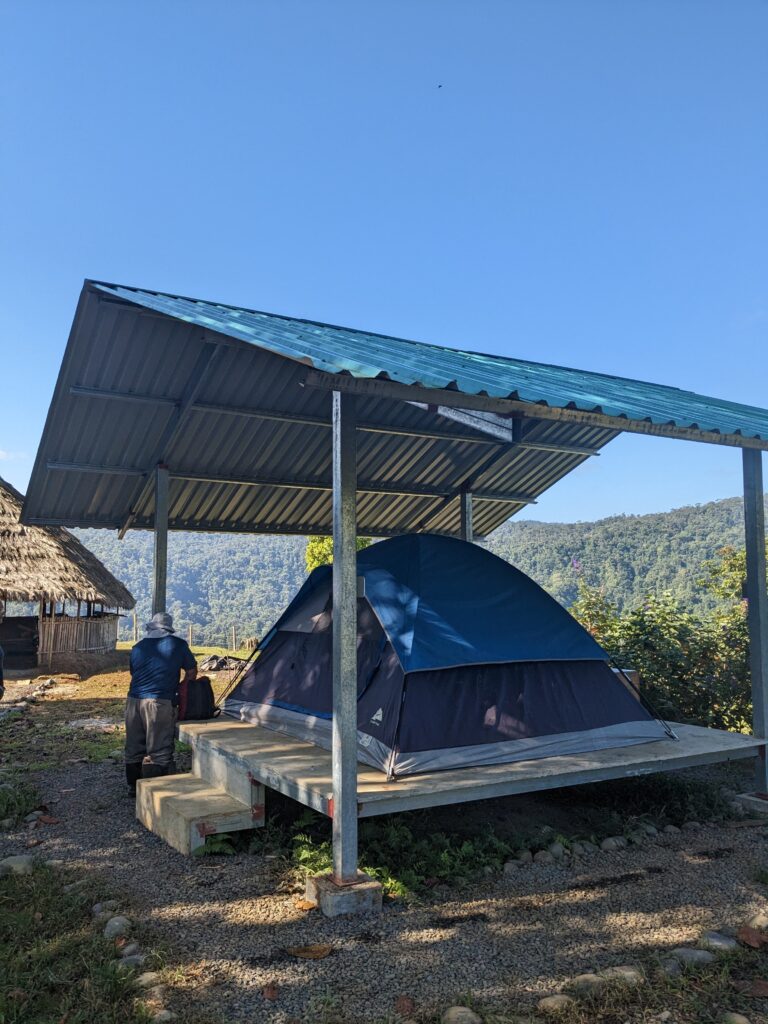
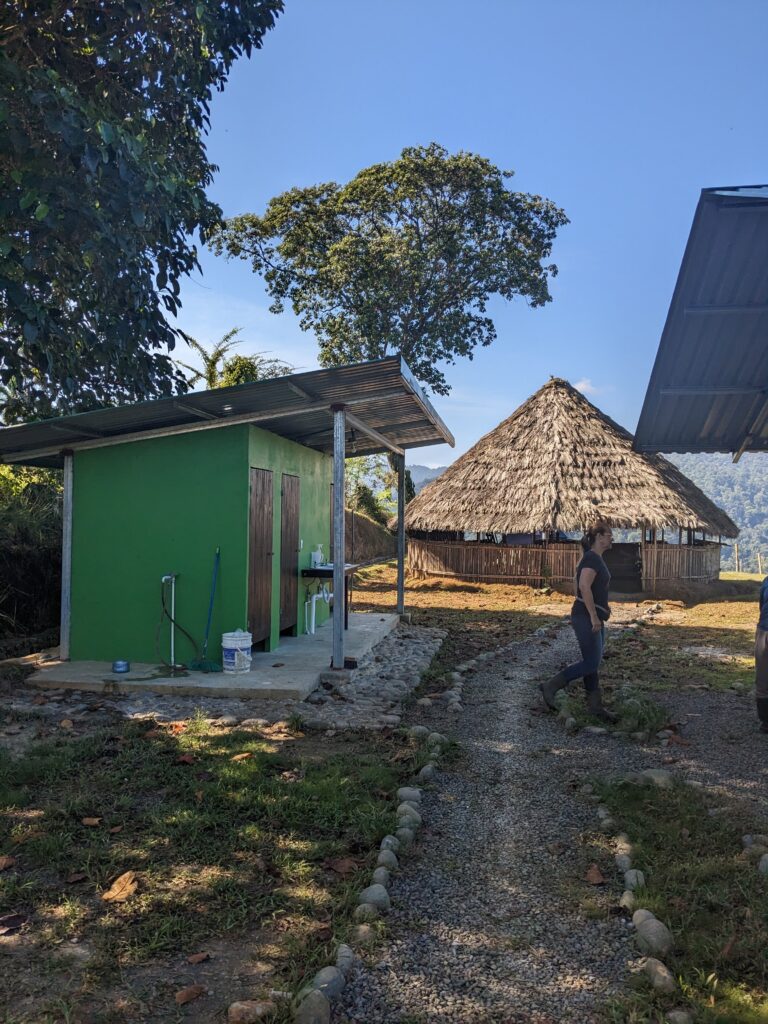
I explained the menu choices to everyone and one server helped by telling us we could order from both sides of the restaurant and put it all on one bill. Most ordered tacos de birria and loved them. Others had the cosada, fish taco, fried plantains, or soup. They all agreed that they liked Soda West better than the hotel restaurant and asked if we could return on Tuesday and Wednesday. We also liked that the cost was almost 50% less!
We walked back together and I bought beers for several in honor of their first day and accomplishments. Hélène also ordered a hot rum toddy to help he sore throat.
We sat around the pool sharing snacks, stories, and drinks for about an hour before I excused myself and went to bed. The others stayed for another 15-20 minutes when a hard rain started, but was an excellent first day!

Tuesday March 21
I arrived at breakfast at 6:30 and sat at the head of our large table. Akash, Zohaib, and Karthik joined me shortly thereafter. The others trickled in slowly. The van arrived at 7:15 and I loaded my gear, then sat down to write and check email.
At 7:27, I reminded the team that we would be leaving at 7:30 as they finished their coffee and breakfast. We don’t leave until 7:45 when our last two stepped on.
The drive to the worksite was much cloudier than the previous day and it seemed like the off-and-on rain we’d heard overnight might continue.
We stopped once at a large tree and Vicente again pointed out the toucans. This time, I was armed with my 400mm lens and got some good shots of the birds.

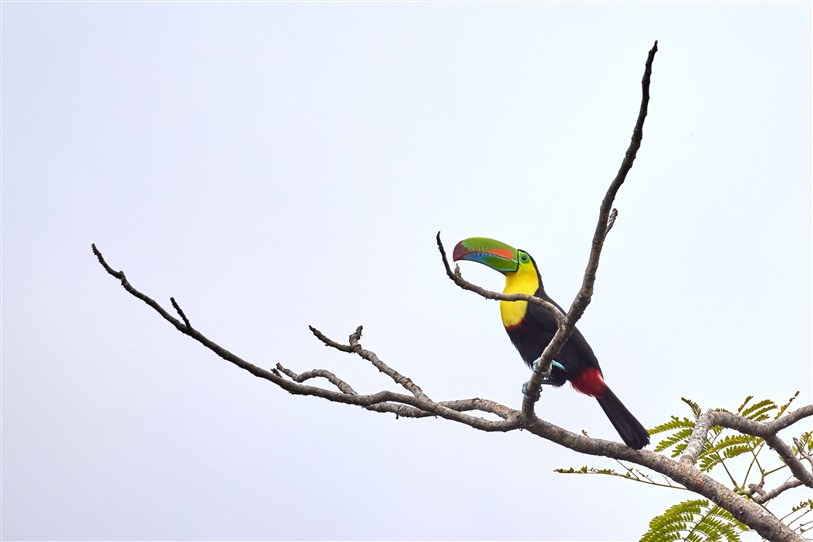

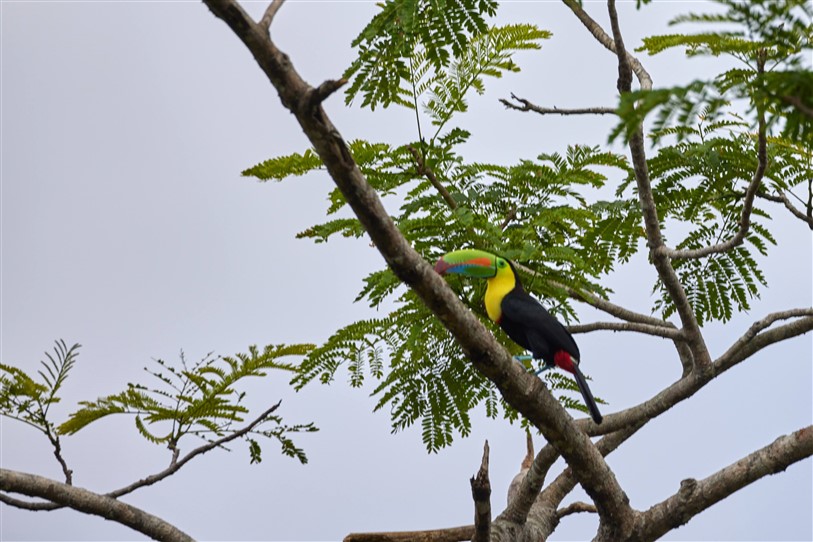
We arrived just after 8:30. Marine told me the plan for the day, confirming that we would be playing football against the locals high school kids and others at 2pm.
Our wire benders made quick work of their fourth rebar column and presented it to Carlos so that we could proceed with pouring and setting the pedestals.
I helped Carlos set the levels and framing for the pedestals, and then Hugo, Tarek, and I prepped an area on which we’d mix the concrete.
Meanwhile, on the pathway, Hélène, Hana, and the others were setting border stones and finishing the side trenches.
Next, we started moving wheelbarrow loads of sand and fine gravel, as well as four 50kg bags of Portland cement down to the concrete mixing area. This was challenging because the wheelbarrows had to be physically lifted and carried down the concrete steps Carlos had constructed the week before. So, when Carlos asked for four full loads, we negotiated that we would bring down eight half loads.
Once those were dumped, we carried even more down to set another pile for mixing.


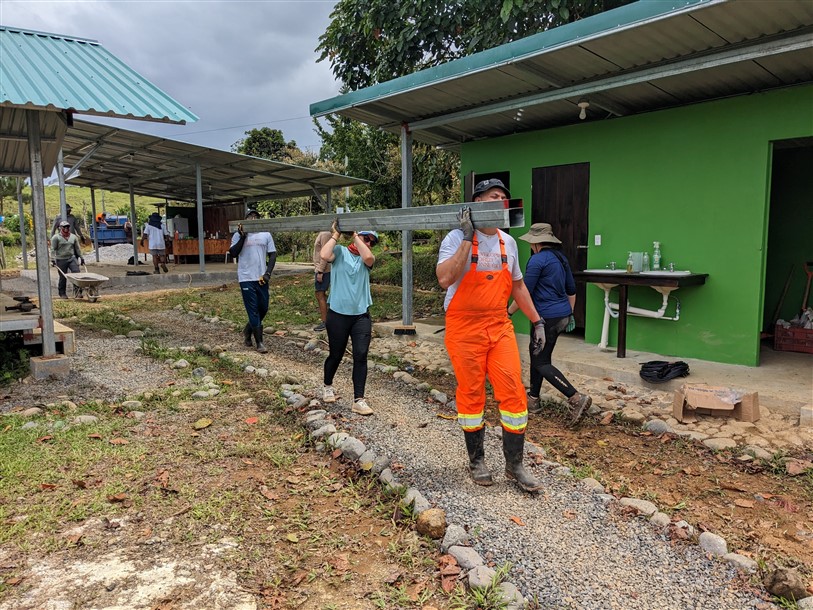
At about 9am, our building supply driver and his dump truck arrived with more material. This included 10 of the two meter half-pipe conduits so that we could finish that work, even more large, round, white border river rock, LOTS of steel beams and columns which when we’d build the camping platform, corrugated steel roofing sheets, and four sheets of one-inch thick concrete board.
The whole crew helped unload the steel components and place them in the thatch ranchero. Moving the concrete panels–that would form the actual camping platform surface–was amazingly difficult. The sheets are about 1.50 meters by 2.50 meters and must weigh over 100 kg each. It took six or seven people to carry each one to the ranchero where we stood them on edge waiting for further instructions. Carlos told us that he needed them all of the way down the hill at the new camping platform, but since we didn’t have a flat area to put them they stayed in the ranchero. Lugging them down the hill would occur another day.
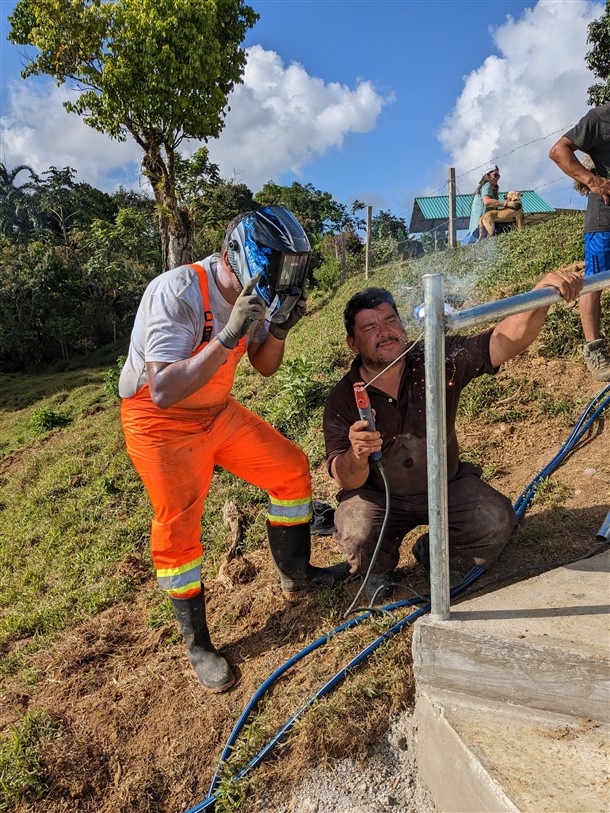
The halfpipes were delivered to the unfinished area and Helene, Zohaib, and others finished the digging to run the lines up to the main flat area. They had to negotiate several small turns and two large ones that would be filled with cement later by Carlos and his team. However, they finished this work quickly and soon the new 10 pieces were in place and that huge amount of work was completed for our week.
Hana’s team finished the larger trenching work on the lower section of the trail. Because of the steep slope of these two sections of trail, we asked Carlos if we should put some cross lines of larger round stones on the path that would stop the large gravel (that would later be covering it) from sliding down the hill–in others words, some shallow steps or barriers to stop possible gravel sliding. He agreed and we went to work on that, cutting shallow lines across the trail every three meters and setting smaller round river rock.
Meanwhile, down at the future camping platform, Carlos, Hugo and a few of the locals were mixing concrete for the pedestals, setting square concrete blocks around the rebar structures, and pouring the pedestals throughout the morning. When complete, each pedestal had an even top surface with four pieces of rebar squarely extruding from their top. Carlos would use these and welded metal plates as anchors to the tall galvanized steel beams that would support the platform and (eventually) the roof. Extra concrete was carried to the drainage canal to seal the gaps between pieces and affect the turns in the lines from trenches coming off the main level. Vicente, our driver, did much of this work.
Before we knew it, lunch was ready. Today, we had manioc root, the always present rice and black beans, some fresh, boiled palm hearts, and either chicken or pork. Jugs of juice helped with our thirst, too. Everyone seemed to be enjoying the local food and there was plenty of it. Our chef, though very quiet, seemed to be a big improvement over what we experienced in our previous trip and all appreciated her hard work.
The dogs had found us, however, and they were a bit of a problem, begging for food throughout the meal–almost a dozen of them. Each tried a different tactic. Some sat like good dogs just outside the doorway looking in with sad, hungry puppy eyes. Others were more brazen and came through the doorway to beg at our feet and put their paws on our laps–which we discouraged. No one fed the dogs (under my orders), but there was a lot of sympathy in the group for these obviously underfed friends. Later in the day, Helene would ask me if it would be okay if the team bought a large bag of dog food to donate to the community to feed the dogs–something Deepak had asked me the day before, too. She had already asked Marine if that would be a good gift for the community. Marine assured her that it would, but that she needed to check with me. I told her that that was okay, but that we couldn’t actually feed the dogs–that was the job of their owners and the community.
After lunch, we finished some small tasks around the work area and spent a short, very energetic spurt of time placing remaining border rock along the trail. Marine walked down to tell us that it was time to play football with the locals. Several of us wanted to stay and do more work, but she and Carlos convinced us that the football game was of equal importance, at least. Carlos also wanted to complete the steel handrailing on his concrete steps and couldn’t have people and wheelbarrows of gravel passing behind him while he was arc welding. In the ned, Tarek and Hannah stayed behind to finish the trail borders and trenching and the rest of us got on the bus with Vicente for the game.
We drove about two kilometers back along the road to a pull off and cut through the bushes that opened into the football pitch. There was a small, low, covered spectator structure on the west side of the field where some of the high school students were sitting, waiting for us while others warmed up on the field. The field had two permanently installed goals (without nets), a large puddle (pond?) at midfield, and several hundred cow pies of varying levels of freshness scattered among occasional patches of grass and weeds. It was generally flat except for the bottom of the pond.
A few minutes later, the school’s teachers and principal arrived along with more students and several community members. Our group put up a team of eight and received three extras from the pool of locals. We also had substitutes, with Kellie watching at first, but rotating in later. Helene was on attack with Zohaib, Deepak in goal.
The principal decided that we would play a 15 minute game. The opposition scored in the first two minutes, but DWC/Salesforce held tough and that’s how the game ended. No one seemed too bothered by the cow pies and there were no significant issues with them that I saw. Zohaib did “tackle” one young lady who limped off the pitch and was then examined by Helene and others. Her lower leg was clearly not broken–just bruised–but she was taken home, carried to the road on Helene’s back as her mom walked alongside.
Next the locals played a game amongst themselves that we watched. Clearly, some of the kids had impressive football skills and they played a very spirited, fast game. The participants were mostly high school students, but some elementary school kids as young as 10 played, as did some other locals that looked to be at least 30.
This game looked to be headed for a shootout, but a late goal into the south end sealed the win for the team that looked a lot like the best high school boys and girls.
DWC/Salesforce took the field for the final game. This 15-minute match ended in triumph, though, as Zohaib punched a shot through the goal at the midway point. I think they let us win.
This game was notable because, mid-match, a local cowherd led his animals across the corner of the field. I don’t think any additional deposits were made by the cows. A few minutes later, a small, black pig also decided to get into the action and scampered across the opposite side of the field from where the cows had crossed.
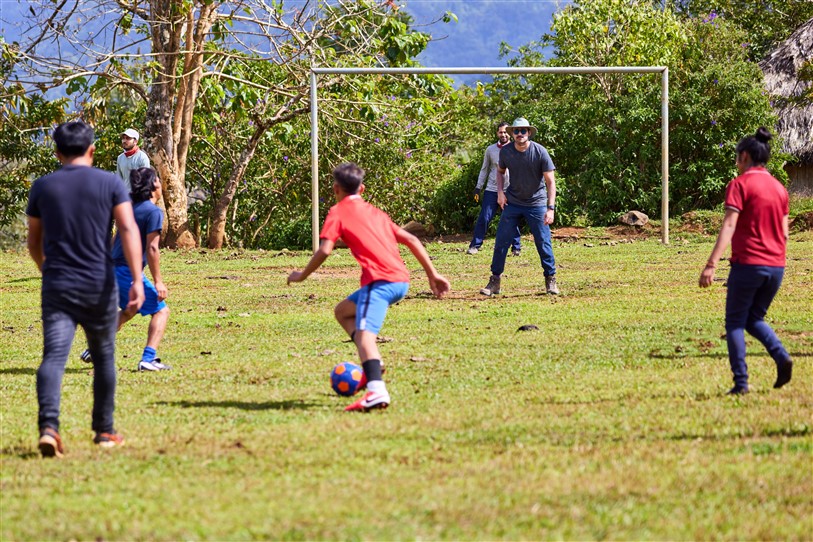
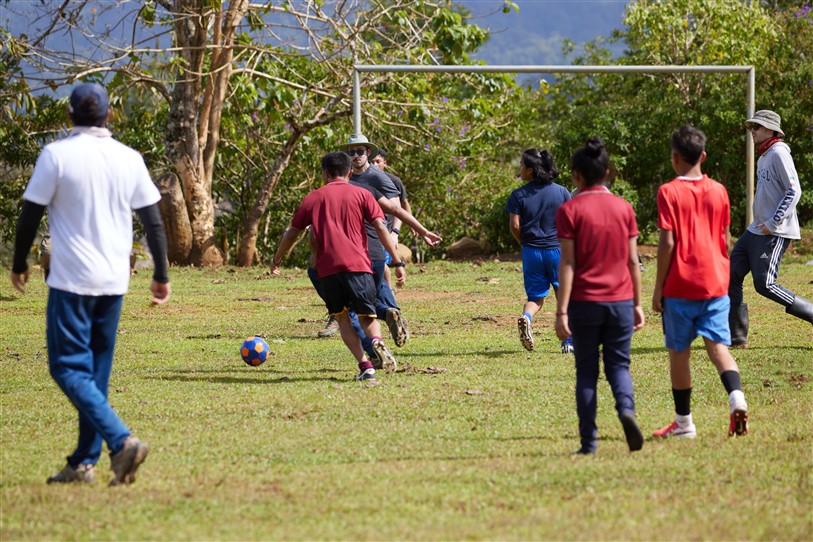
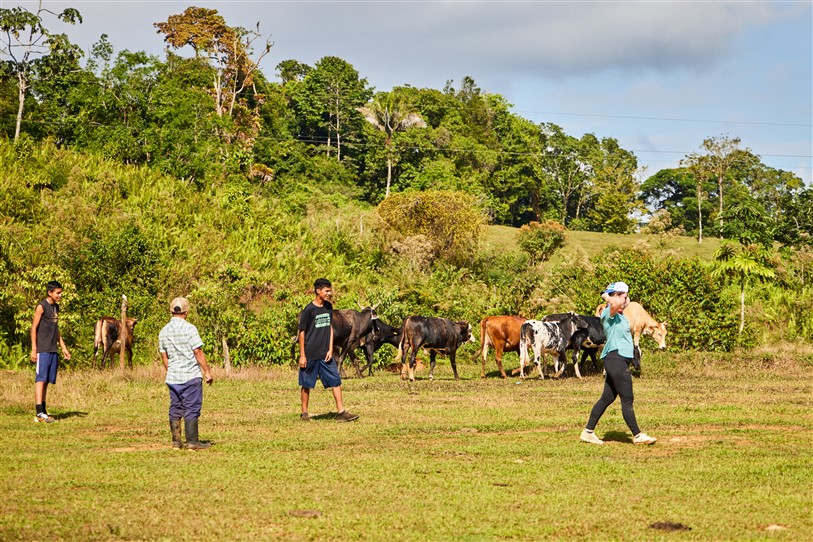
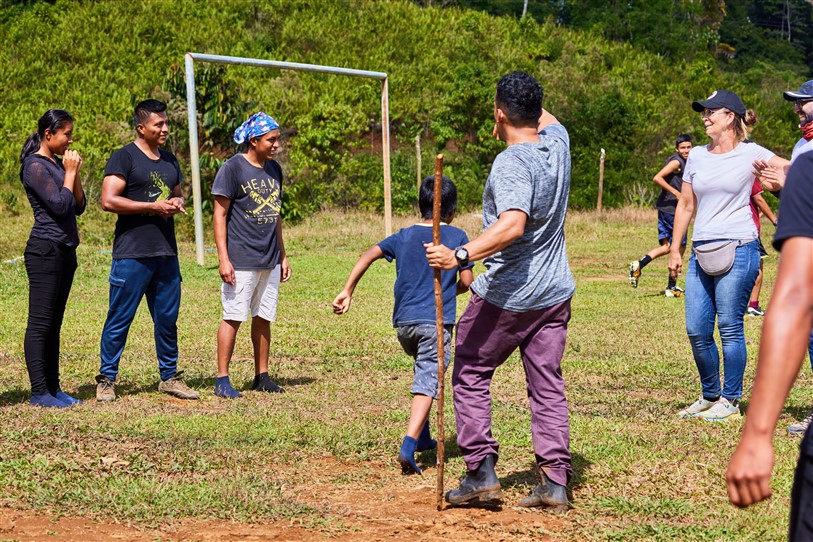
Following the game, Marine passed out platters of cut fruit for refreshments that were shared among our team and the locals. We all posed for photos and then returned to the worksite.
When we returned, Tarek was arc-welding under the watchful eye of Carlos, touching up the last welds of one of the railings. He’s also used the angle-grinder to cut the vertical beams for rail fitting. Hana and he had completed all of the border work on the trail as well.
We decided to call it a day and everyone helped gather the tools. We cleaned the tools with brushes and water and stored them in the bathroom shower area. Before we boarded the bus, Carlos showed Marine and I what he wanted to do on Wednesday. First, he wanted a group to sort the river rock by size into three separate piles. He was insistent that a better job of this be done that had been done on Monday. He said that we would be completing the gravel path and that we would also add more gravel path in the upper section of the camping area leading from the parking spot, past the kitchen to connect with the paths we had completed the previous June that ran between the bathroom and the original camping platform and too the ranchero.



Carlos also told us that the heaviest work on Wednesday would be digging a new septic tank pit in the lower section. We agreed and boarded the bus.
Three of the local leaders got a ride with us down to the Siquirres. Some members of the team wanted to go back to the MaxiPali and also to a local pet food store to buy dog food, then walk back exploring the town and maybe eating locally. Our driver dropped nine of them at the pet food store, led by Zohaib, and they assured me that they would stay together as a group and notify me when they had safely walked back to the hotel.
The other six of us returned to the hotel and decided to go to Soda West for dinner at 6:30pm.
I cleaned up, checked email, and returned to the lobby after speaking to Becky, my wife, by phone–back in Colorado.
Daniel, Mitchel, Karthik, Tarek, and Hana met me at 6:30 and we walked over. All in the group wanted more tacos from the chile restaurant and we weren’t disappointed. We joked about having three straight days of “tacos de birrias.”
As usual, our conversation was animated and informative. Tarek’s and Hana’s experiences in the Middle East are fascinating.
The other group of nine walked by us on their way back to the hotel at about 7:30pm. We were just behind them and met in the hotel lobby. Zohaib gave me their dinner receipts and I reimbursed Partha, who’d paid for the dinners. We agreed to meet around the pool again for late drinks and snacks, led by Helene who’d bought a bottle of rum. I stuck to my nightly Imperial cerveza, but did have a sip of the rum. We shared stories and photos and all agreed that the project was going very well so far.
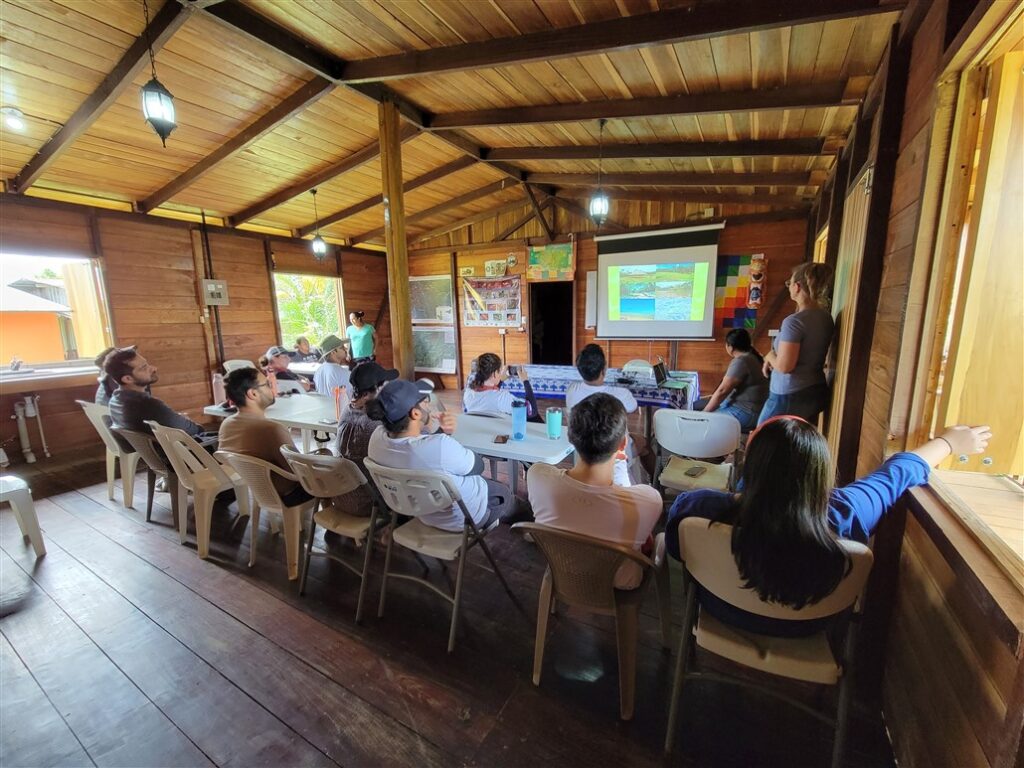
Wednesday March 22
On Monday afternoon, Tarek and Hana asked me about arranging a pre-dawn breakfast for them due to the start of Ramadan Thursday morning. I told them that we would work with the hotel to do just that. Hélène helped me at breakfast today by speaking with the front desk. The young lady there assured us that they could prepare fruit plates the night before and place them in the soft drink/beer coolers in the lobby so that would be ready when Tarek and Hana got up. I was very impressed with their flexibility in this regard and willingness to help.
The group straggled in for breakfast and most agreed that they were more tired and sore on the third day than they were on the second.
A few (Daniel and I) had been awakened by a heavy downpour during the night, but most had slept through it. The weather was still very cloudy and rain threatened.
As 7:30 approached, I went to the van to greet Vicente and Carlos. At 7:30, We were the only three on the bus that was idling in the parking lot.
Most of the others joined quickly thereafter, but not all.
We almost left someone behind this morning. At 7:40, one team member was sitting in full view of the running bus–with all others inside the bus–calmly eating breakfast. I twice stepped out and told him that we were leaving. He didn’t acknowledge me and kept eating. I went back to the bus and told Vicente we were leaving in one minute. One minute later, Vicente started to back up. A few on the bus asked him to wait. The moving bus got the laggard’s attention and he stopped eating and walked to the bus. I hope it’s a lesson learned. We’ll see. All others, though, were in high spirits.
Five minutes into our drive, a heavy rain started. As we turned into the gravel road, it looked quite slick. Several of us started to pull out our rain boots, but then the clouds opened and it stopped. The weather had been remarkably cooperative for us on this trip, with just a few refreshing sprinkles during our work periods and the heavy rain keeping to the wee hours of the morning.
The group was fairly quiet on the drive-in. I think it was a combination of fatigue, rain, and the drama of almost leaving a team member at the hotel. Most dozed during the whole ride.
Unlike our trip last June, bugs did not seem to be a problem this trip during the dryer season. I have not yet seen a mosquito, though some on the team have tiny bites from what appear to be other bugs. Sunburn has afflicted more than bugs and rain, though most have been generous with their sunscreen and worn hats and/or long-sleeves.
When we arrived, I asked Zohaib to speak directly to our fellow team member about their behavior at breakfast and being late and he agreed that that was the right way to handle it. Mariné met us when we arrived and told me that Diana, the Barilla National Park Ranger, would give the group a presentation and tour at 11am, then, during lunch one of the local indigenous women would give a presentation about the indigenous community’s organization, associations, and activities.
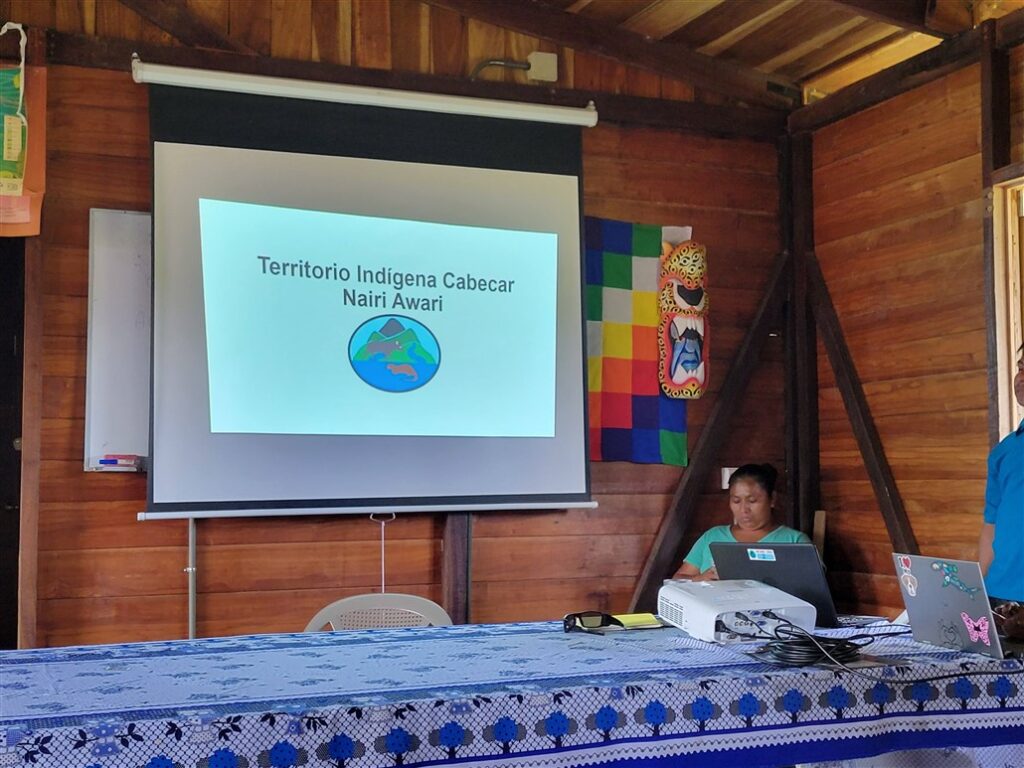
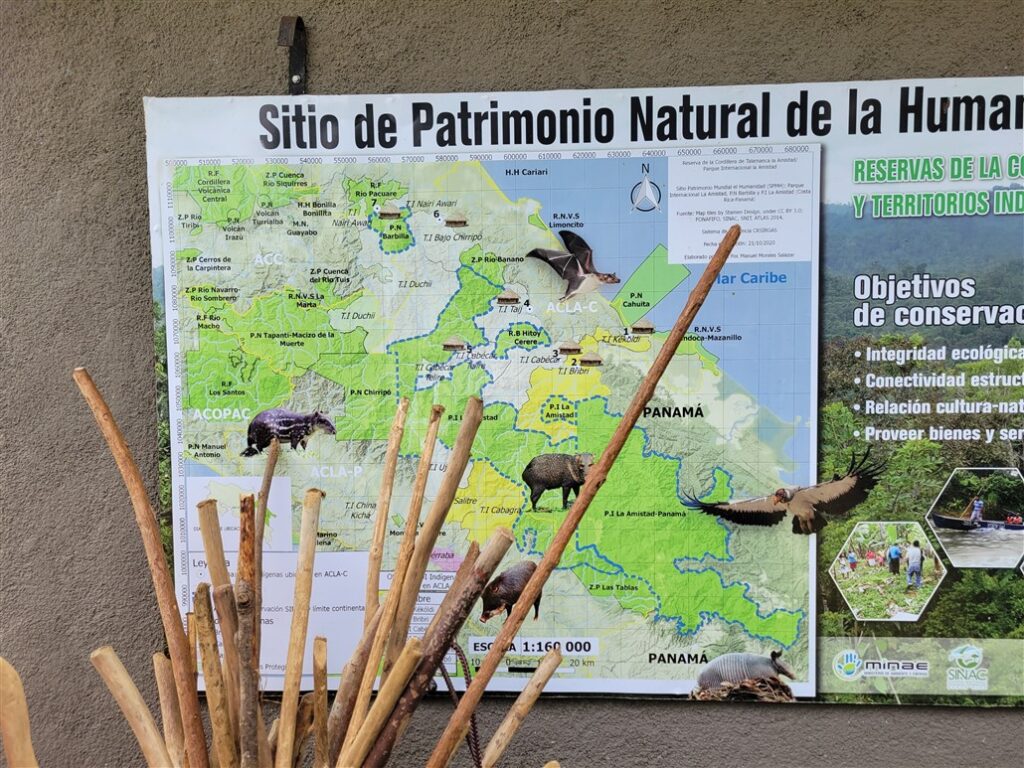
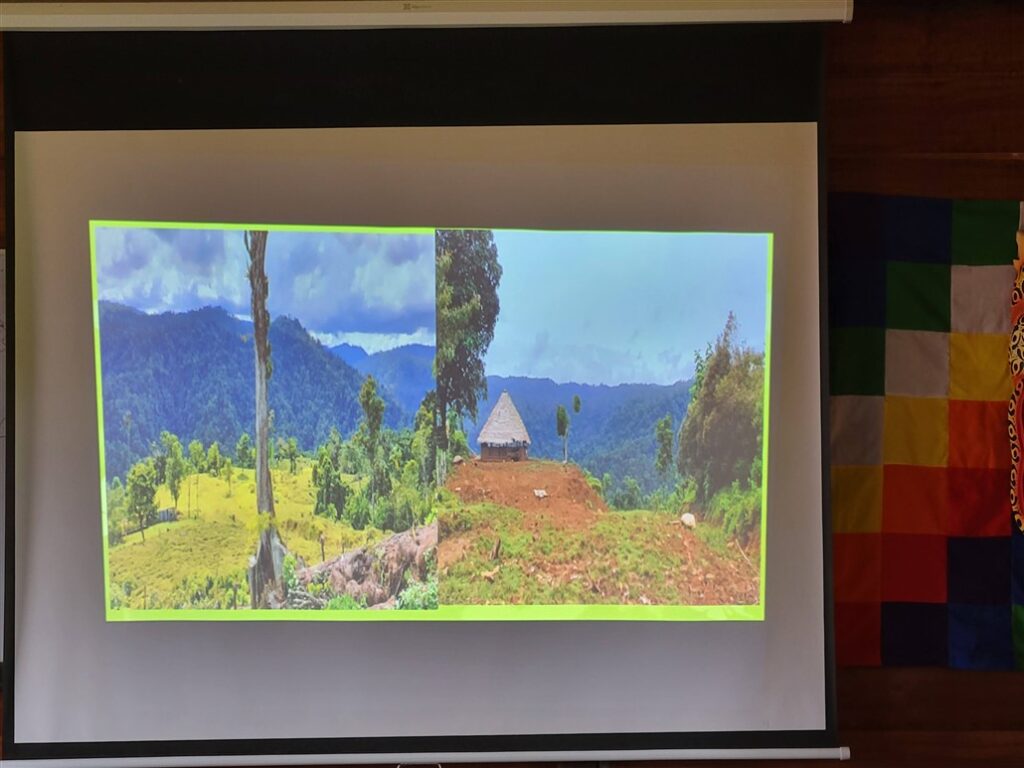

Next, Carlos brought everyone over to the river rock pile and very specifically gave everyone a demonstration of exactly how he wanted the rocks to be sorted by size and shape. We let a team of four or five there to take care of the several tons of white rock.
Small batches of concrete were mixed by Vicente and Hélène went to work sealing the final gaps in our drainage run.
The primary morning task for the guys was to move the concrete sheets that would form the base of the camping platform. These sheets are 1.22 meters by 2.44 meters by 2.54 centimeters thick. Or, as we Americans say, four feet by eight feet and one inch thick. Later in the day I did an internet search and found that the weight of concrete is 12.5 pounds per square foot, one inch thick. That made each of these five panels (at 32 square feet) 400 pounds or 182 kilograms.
We needed to move each of them almost 100 meters down the concrete steps and pathway to lay them beside the to-be camping platform. Each trip would take eight or nine people carrying the sheet–or roughly 50 pounds each.
The task was complicated by light right that slickened our path, but we managed to do it without injury again. The key here was that each carrier held each board in the same position each time down the steps and path, so that they were familiar with their footsteps, carrying angle, and when more of the load would be on them.
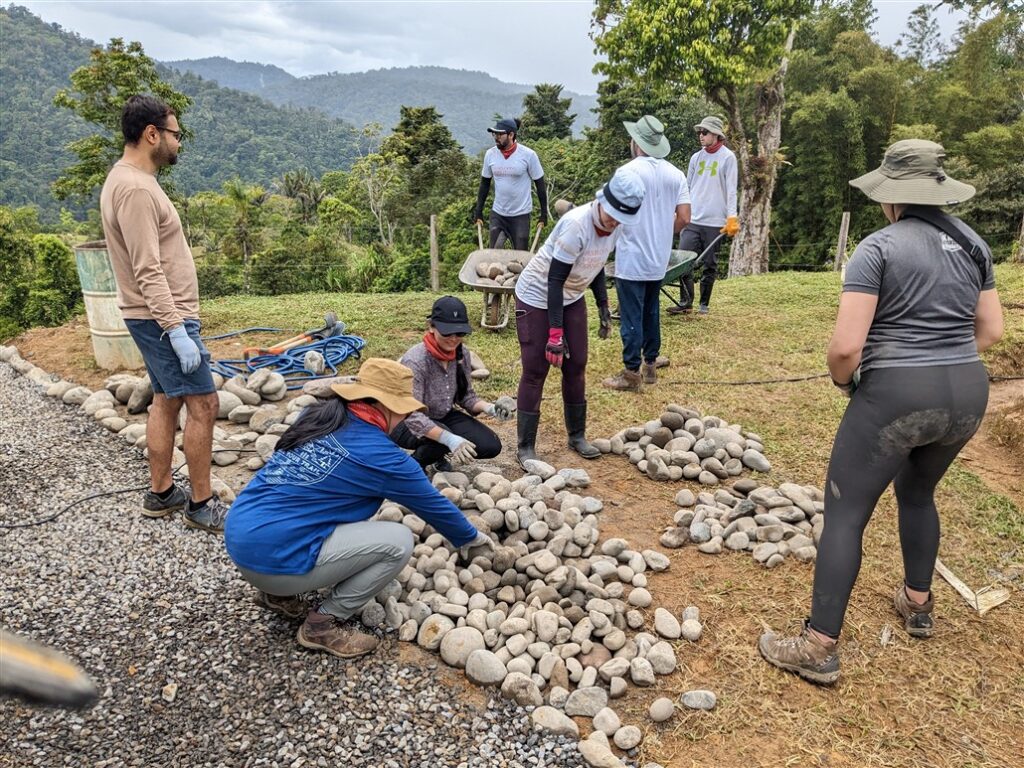


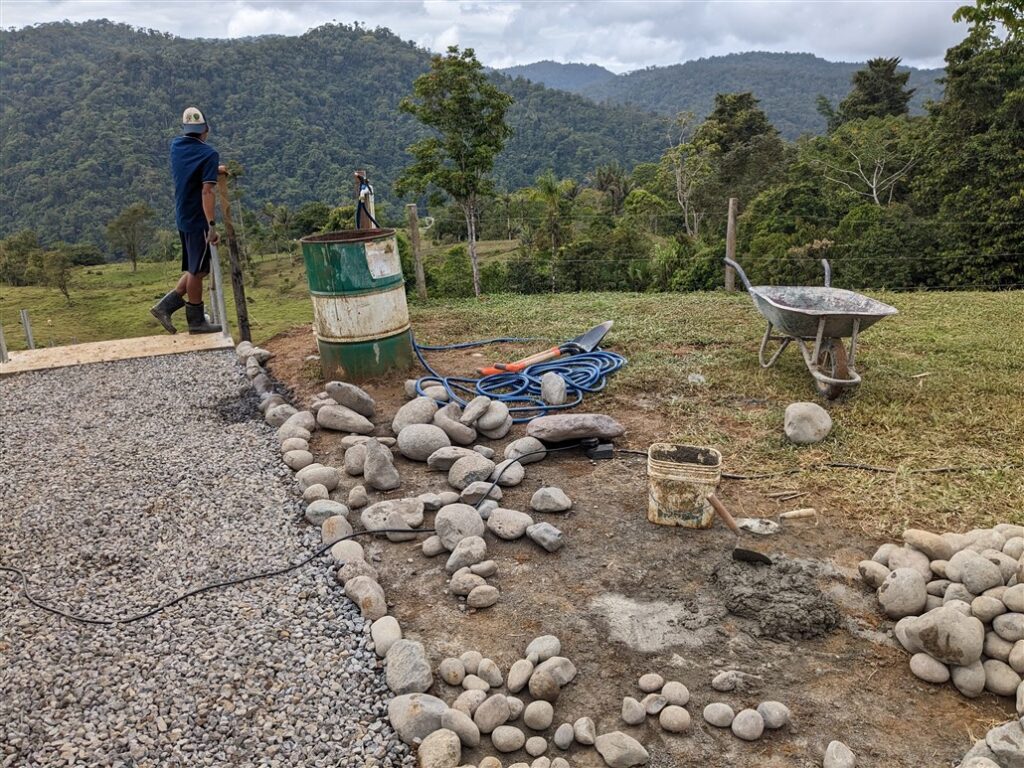
Most of the rest of the team now returned to rock work, extending the trenches on either side of the lower path and setting boundary stones of the (now) correct size along the way. A train of our two wheelbarrows was working continuously to supply materials with people stationed at the concrete steps to help carry the wheelbarrow and its contents down the steps.
Next, Carlos asked me to finish the tops of the drainage runs with concrete that Hugo and I mixed in a wheelbarrow. The others concentrated on moving rocks and digging to finish the path down to the lower level, including more trenching and placing of the sorted border rock.
Carlos was welding together support plates for the camping platform’s vertical columns while Vicente ground them flat. Once complete, Carlos welded the plates to the bottom of each column. I meanwhile mixed a small batch of concrete under Vicente’s watchful eye and did some finish work on the top of the drainage runs–essentially a concrete transition in each ditch from grass and dirt to the concrete half pipe conduits.
By now the main group had taken a break. They then did more path work and then, at 11am, went to the Barilla National Park headquarters and ranger station, led by Ranger Diana who gave the same presentation to our first group last June.
Vicente and Carlos were arc-welding the base plates to the vertical camping platform columns and I carried them down the hill to Hugo who was painting the weld sections to inhibit rust
While the presentation was happening, I stayed behind to help Carlos, Hugo, and Vicente mount and weld the columns to the pedestals. We had to clip the corners of the steel base plates to make them fit better, too. We used several levels and all four sets of hands to make sure the columns were perfectly vertical when welded into place.
When complete, we used large bolt cutters to trim the four remaining pieces of excess rebar coming up from the final pedestal. Carlos went first, then Vicente, me, and Hugo last. By the time I was handed the cutters, it was clear this was a contest of strength–seeing who could cut the half-inch rebar the fastest. I used all my leverage and cut mine quickly–to the delight of Carlos. Hugo got the last one and, frankly, it was the most awkward with the worst leverage. His struggles made Carlos and Vicente chuckle and Carlos said that the oldest were the strongest in the end.
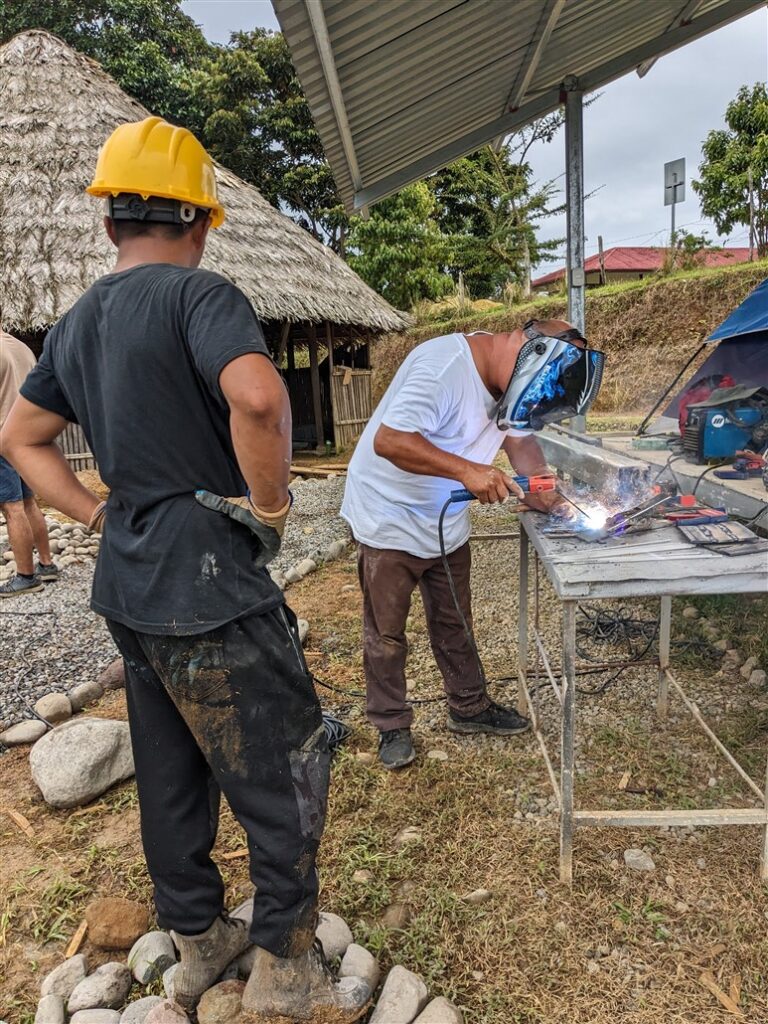
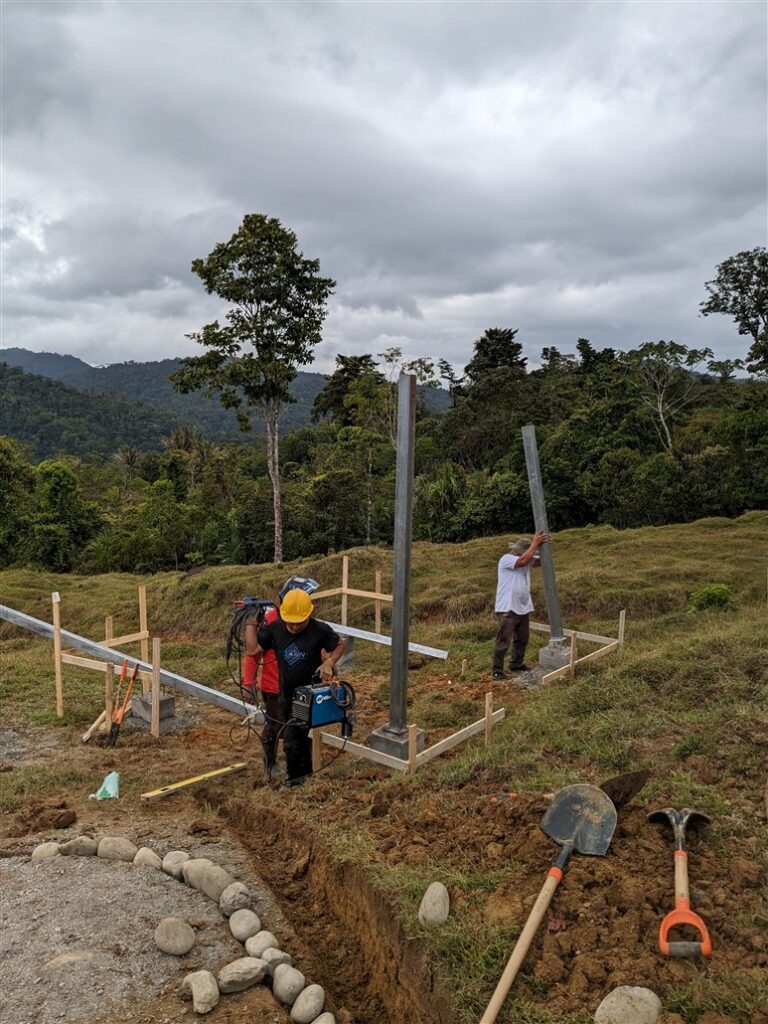
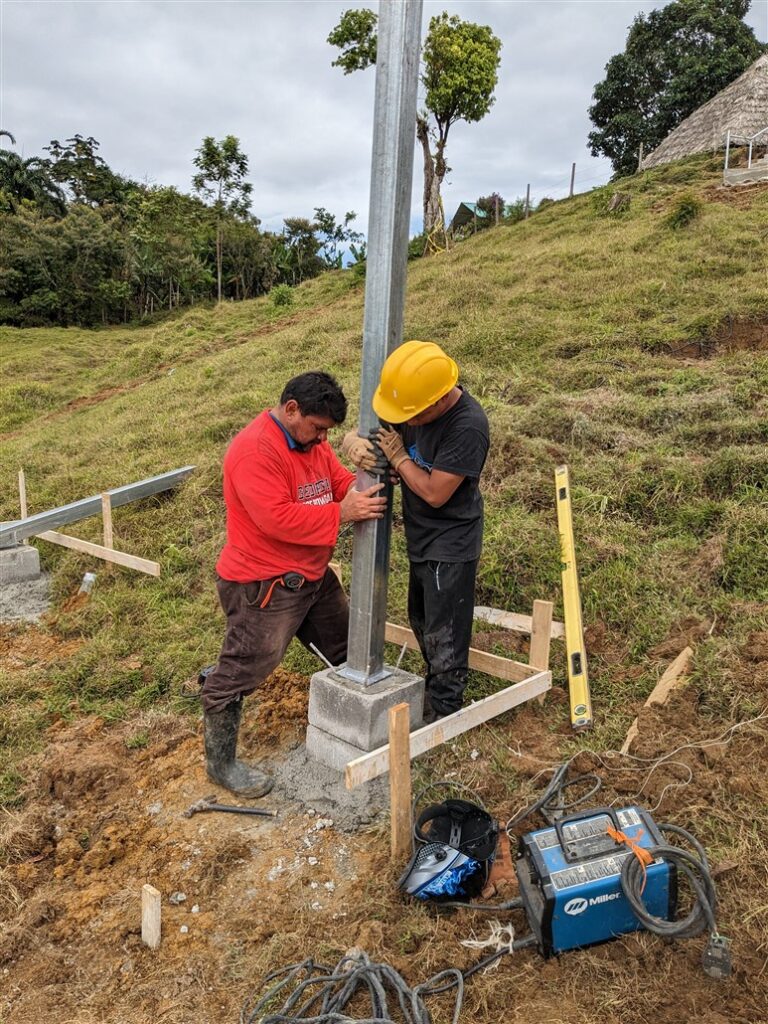
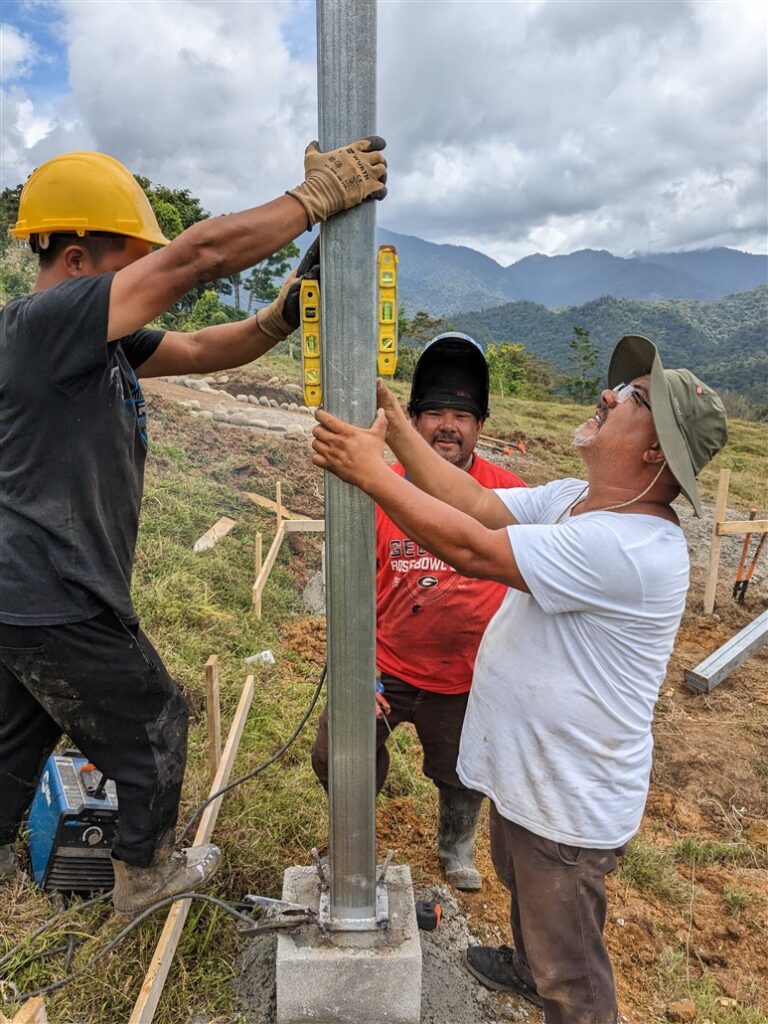
By now, the ranger presentation was over and Karthik and Terak joined me in hauling and cutting horizontal steel 2x4s that would form the main support square for the concrete sheets. We measured each length and I cut them to length with Hugo’s guidance.
Each of the four pieces were a little long, so we remarked them and recut them to size so that Carlos could weld them on–as usual, perfectly horizontal–using a set of clamps to hold them in place. We were having trouble getting straight cuts, even using levels and others to support the beams while cutting. Gradually, it became clear (after almost every male in the group tried their hand at it, assuming that THEY could do it right) that the cutter was just not square, so Vicente began making the (now) well-labeled cuts with his hand-held angle grinder. This took more time, but was more square and made Carlos’s job of welding the pieces to the structure quicker and easier.
At lunch, we joined the others in the wooden community center for a presentation by the local Cabecar leadership that explained their organization, heritage, beliefs, and other issues. It was very well-received, translated by Mariné.
The team was very happy with the presentation and asked about other ways they could support the community, such as buying crafts. Mariné told them that we would have a short end-of-day coffee on Thursday during which time we could see some of these crafts and learn more about the community–something that pleased the whole group.
After lunch, most of the group gathered at the base of the lower path and around the new camping platform to get instructions from Carlos. He outlined the final meters of the path, showed us how to build a rock-covered drainage run past the platform, and told us that he wanted to build the step from the ground up to the platform from large rocks capped by smaller ones in concrete. The team finished the borders of the newly understood trail quickly using a steady train of rock carriers bringing the precisely-sorted pieces to their appropriate place.
Then, Carlos gave everyone the go-ahead to complete the trail by hauling tons of one-inch gravel down from the big piles to take its place between the path border stones.



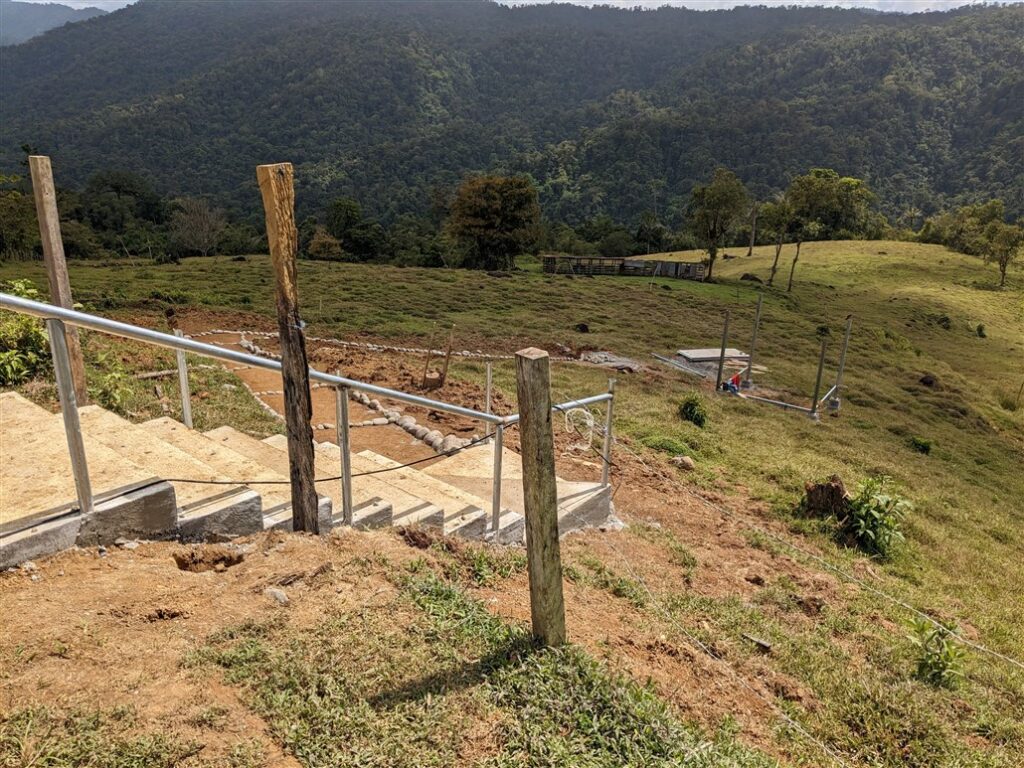
This was perfect work for the team. We had a goal, we had the materials and people, everyone had a role, and we could see our progress.
This also allowed Carlos and his team to arc-weld the supporting cross-beams to the camping platform without distraction.
Kellie and Mitchell shoveled several tons of gravel into waiting wheelbarrows that were shared among all of us. We stationed people at the steps (Zohaib!) to help move the wheelbarrows down to where the gravel was needed, and everyone took turns pushing wheelbarrows and emptying them exactly where the gravel spreaders with their shovels and hand rake wanted the stone. I was amazed at how quickly everyone worked on this, easily moving ten tons of rock over 100 meters downhill and completing it well before 4pm. Their high-fives all around and all seemed very happy not only with the work accomplished but with how hard they’d worked to see the end result.
Carlos was also able to complete the steel cross-beam base of the platform. He told me that the next day we would put the roof on the platform and set the concrete base sheets. Our other tasks would be to extend and complete the gravel walkway past the kitchen at the entrance to the campground and to begin digging the septic pit well below even the new camping platform. I passed this on to the group and, in the words of Zohaib, were “super excited.”
We’d had a near perfect day of weather again, and the descending Sun made the light on our platform quite beautiful during our clean-up. We gathered tools, rinsed and cleaned them, and helped Carlos and his team put it all away securely while also managing to play with the garden hose and spray each other down a little bit for refreshment.
During an afternoon break, Carlos used his language translator app on his cell phone to tell me that he and Vicente very much appreciated my actions back at the hotel when the day started. I thanked him for his support and told him that I hoped that that was the last time we’d face that issue–and that we would leave at precisely 7:30am the next two mornings.
On departing, Mariné mentioned Thursday’s plan again–the afternoon coffee. She insisted that it would only take 20 minutes and that we would still be back to the hotel by 5pm to prep for our 6pm dinner.
During the day, the team also delivered their donation to the local pet community (actually the owners of the pack of dogs that had befriended us) with a 40-pound bag of dog food. Mariné assured them that it was very much appreciated.
When we drove into Siquirres, Vicente first took me to the local ATM where I got enough cash to pay for our Thursday evening special dinner and transportation. Four of the team also stepped off of the bus and told us that they would stay together but walk back to the hotel after probably getting dinner on their own. We then went to MaxiPali to buy a few gifts for the school kids in Tsinikicha, as well as two bottles of rum. Tarek and Hana also bought extra food to be prepared for the start of Ramadan the next morning when they would begin fasting at dawn.
We returned to the hotel and agreed to meet at 6:45pm to go to Soda West for dinner.
After cleaning up and speaking to my wife, Becky, by phone, I came to the lobby and didn’t see anyone. It turns out that the group was already sipping rum around the jacuzzi and swimming pool. I joined them for a quick sip and then four of us (Tarek, Hana, Karthik, and I) walked to Soda West.
We ordered tacos, sides, and tortilla soup and the others joined us about a half-hour later–at about the same time that the earlier group of four walked by on their way to the hotel from their dinner downtown.
After eating (for some of us, our third straight night of the delicious tacos de birria!), we straggled back to the hotel. The Salesforce team, or most of them, reunited at the pool for another round or three of drinks, but I returned to my room to manage receipts, write, check email, and get some rest.
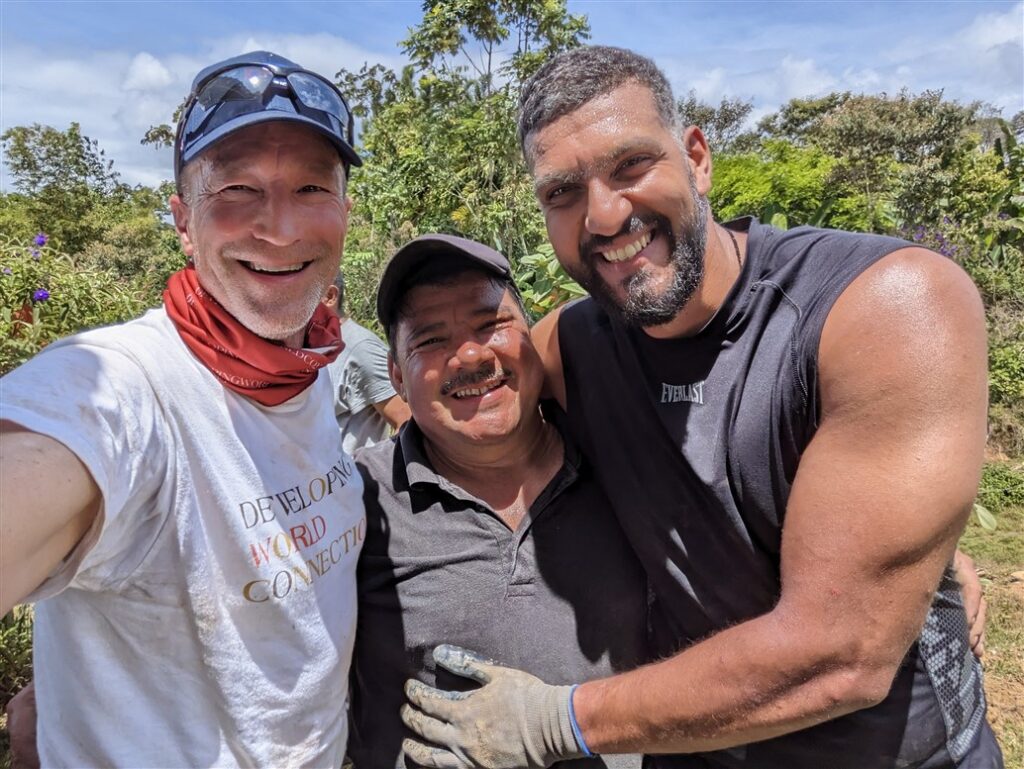
Thursday 23 March 2023
Our delinquent teammate was the third one down for breakfast this morning, arriving by 6:40 am. The rest of the team sat in groups of two or individually, with never more than seven or eight at the table at one time. The weather looked good again, so we were all ready for another big, productive day.
At 7:25, there were three people on the bus. I called for everyone to board twice and one said that his breakfast had not yet arrived. The same was true for three others, so they got their breakfast boxed to go and we were on our way at 7:33. I’ll consider that progress.
The drive into the site was very clear and sunny. We dropped all of the team members except for me at the local high school where they would start their day with presentations and performances by the local students.
I continued on with Vicente and Carlos to the work site and met with Hugo and the others. The first thing Carlos and I did was stake out the extended pathway around the kitchen, extending to the gravel pile and main entrance. He explained the way he wanted the water to flow around the exterior of the area and through larger rocks covered in gravel. I would explain that to the team when they arrived.
We next brought out all of the arc welding material and ran the power cords down to the camping platform area. Once that was done, Carlos grabbed a shovel and took me to the area where the septic tank would be buried and the drainage channel would be cut.
He measured and cut a one meter long board and, after he found a spot about 25 meters downhill and south of the camping platform, used the shovel to cut a one meter diameter circle using the board. This would be where we would dig the hole into which the plastic septic tank would be buried. The hole would need to be two meters deep.
About a half meter away from the circle and two the west, we staked out a rectangular area about one meter wide extending from the septic tank area another five meters. This would be the overflow drainage bed for the septic tank. Carlos wanted that section excavated to 1.20 meters depth nearest the septic tank to a maximum depth of 1.80 meters at the far side.
Once complete with the planning, I joined him, Vicente, and Hugo at the platform where Carlos soon began arc welding support cross-beams to the base platform. He measured, Hugo and I did the cutting and hauling, and the work was almost complete by the time the group returned from the high school.
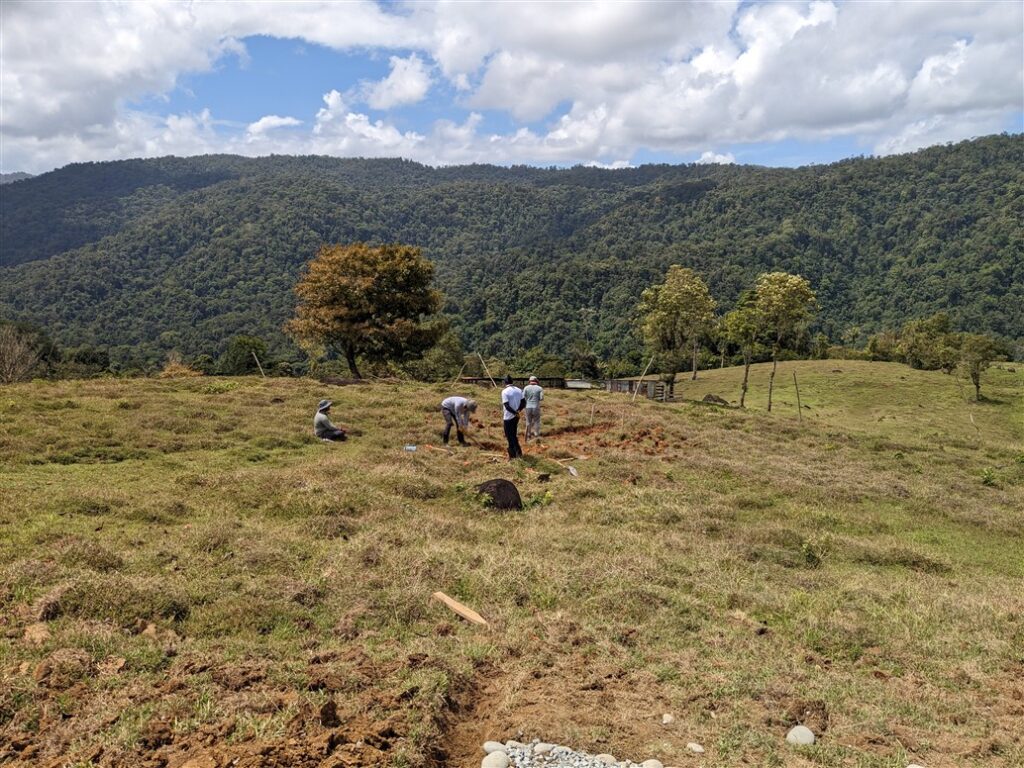
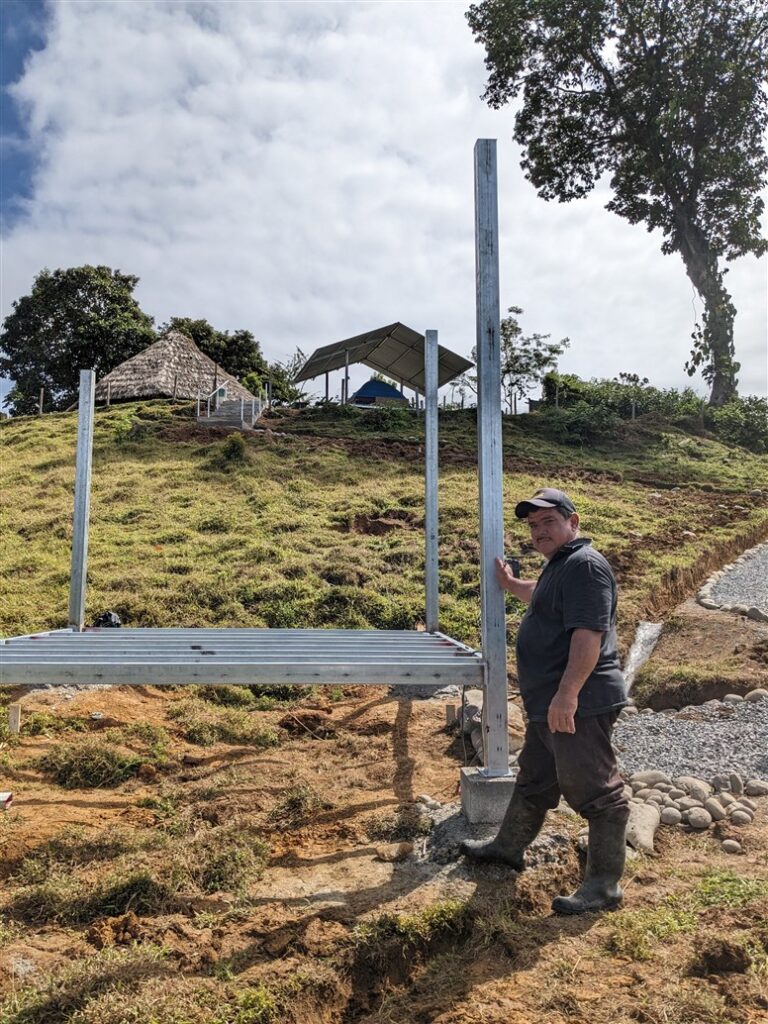


When they did return, we met at the top level near the kitchen and I explained the pathway plan. Hélène and Tarek would be supervising that work and I knew they’d do a great job. I asked several of the guys, plus Kellie, to join me at the septic tank dig and we started work there.
Throughout the rest of the morning, the septic tank and drainage bed digging progressed slowly. The ground was very heavy clay punctuated by large rocks scattered through the area. We took turns digging, hauling mud/clay, and using two rock bars and a pair of pick axes to lever large rocks from the digs.
After Carlos finished arc welding the platform base, we gathered six of us to lift the first concrete sheets onto the platform to be cut and placed. As each was put into place, we used the angle grinder to make small geometry adjustments and make cut-outs for the four corner pillars. Vicente then screwed the sheets into the steel platform supports. It turned out that we only needed four of the five sheets to complete the platform.
By now it was lunchtime, so we returned to the wooden community center building, passing by the new pathway work that was moving along quite nicely.
During lunch, Mariné gave a presentation on her work in the area. It turns out that her father had written a book about the mountainous Tulamanca Range region contained in Barilla National Park and its flora and fauna. The team once again enjoyed the presentation–they really liked learning about all aspects of the area.
The village dogs were becoming more persistent about getting food from us. We’d tried to close the doors, but now some of them were jumping through the open windows. One managed to leap from a plastic chair onto the kitchen counter and was feasting on scraps before being hauled away by Hélène.
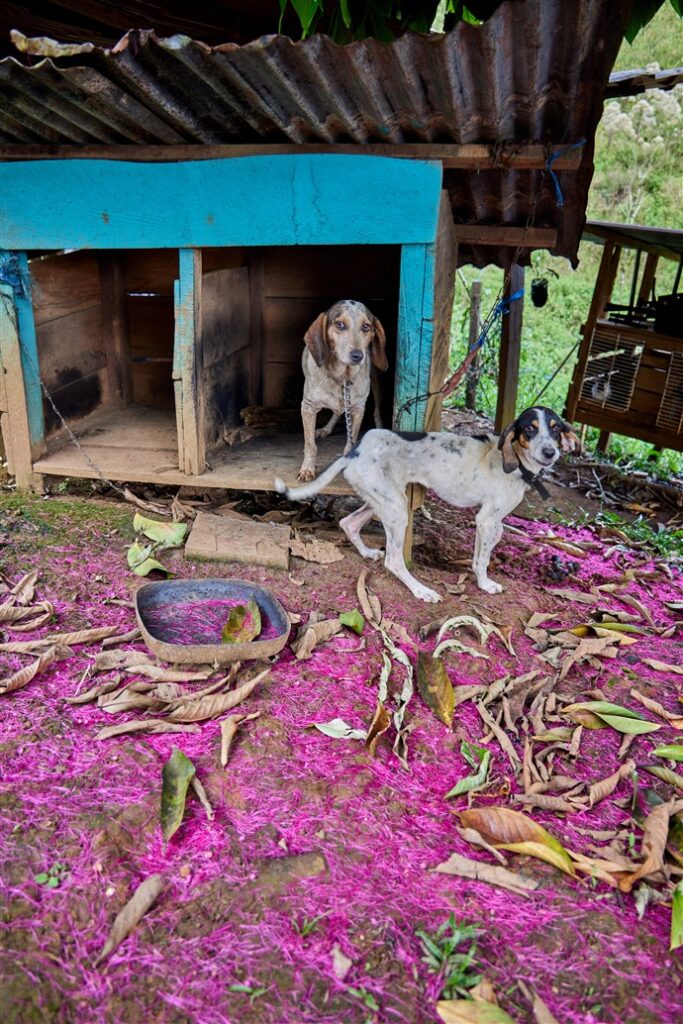

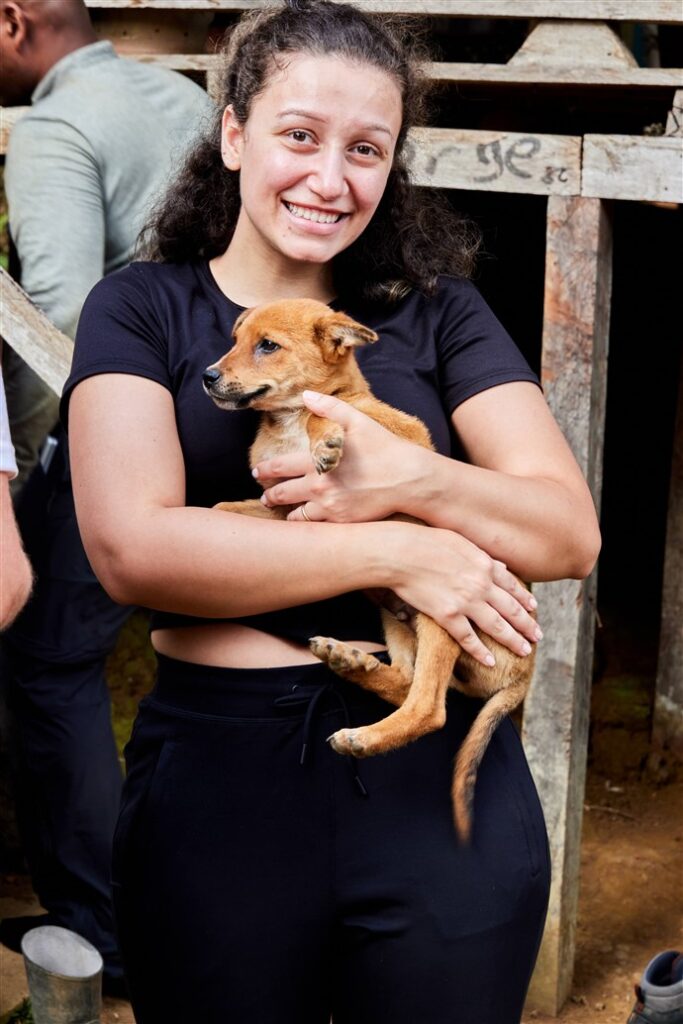
The afternoon was more of the same. Digging continued on the septic pit, punctuated by large rock removal with some of them weighing well over 100 kg. In the septic pit itself, we decided to leave one in place as it seemed to half much less than half of its mass extending into the pit from the surrounding ground. The same was holding true for the leach pit, where we pried free several big rocks. The team was working well changing in and out between tools and locations in the pits, throwing chunks of clay out as others loosened the soil.
At the platform, Carlos continued arc welding the primary pieces that would support the roof once the concrete sheets were fastened to the base with self-tapping screws.
The pathway team completed their work–or, more precisely, they used all of the available gravel on the pathways, added some grassy turf to sections between the paths, and generally did clean-up. Carlos expected a delivery of more gravel before the day was over, but that didn’t occur until we were driving away.
By 2:45, we called a pause on the work and did the usual clean-up. It was a particularly hot and sunny afternoon with still no rain at the worksite, so the early finish was welcome. It was considerable work each day just to haul all of the tools and equipment up from the lower construction area, brush and rinse the tools, coil up the 100-plus meters of electrical cord, and put away all other items into the shower storage area.
Once we were on the bus, Tarek turned on his mobile speaker and played more hip-hop. The team asked what kind of music I liked and I told them that I enjoyed modern, alternative rock. They recognized a few of the band names that I mentioned (e.g., the French band, Phoenix), but claimed they’d never heard of bands like Death Cab For Cutie or Lord Huron. Tarek allowed me to link my phone to his speaker, though, and I called up my Pandora station to play Portugal. The Man’s “Live in the Moment.” They clearly recognized this song and may or may not have videoed a rousing sing-along.
The primary reason that we stopped early, however, was to visit a local home. About one-quarter of the way back to the high school.
We put on our shoes at the bottom of the deck stares and walked behind the house, once again to the sound of barking dogs (they must’ve had a dozen) and the squeals of two boys about six years old running in front of us. Behind the house, we found two large white and gray rabbits in hutches, cages that must’ve previously held chickens or other fowl, more dog houses and a pen with a young, very white and pink pig. Kimberley introduced us to the pig and answered questions about her plans–she was quite energized and focused on growing her little farm.
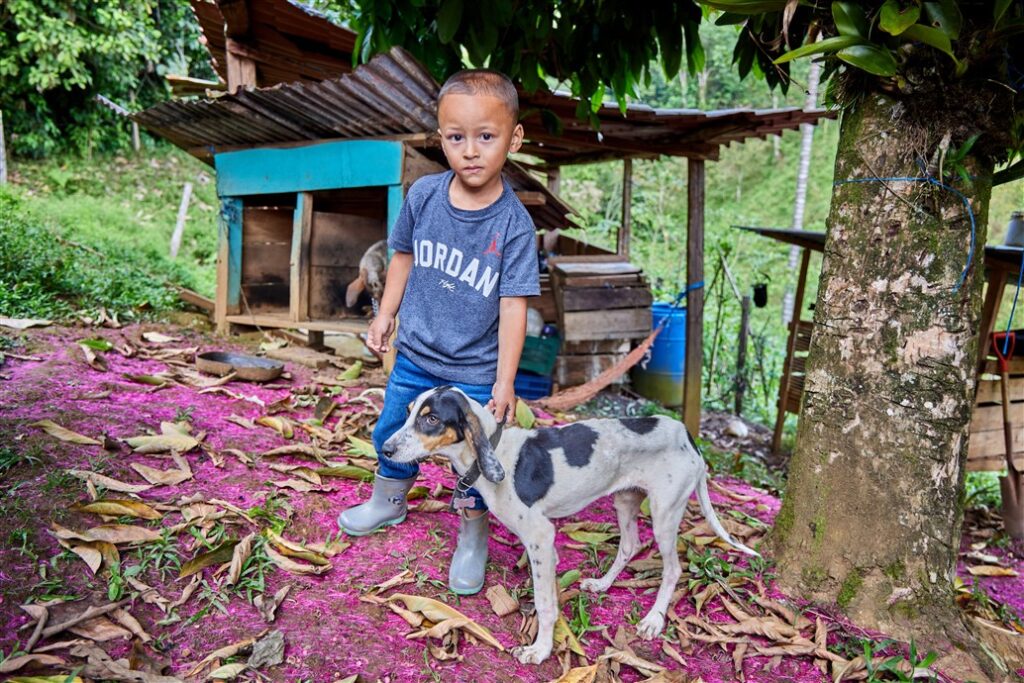
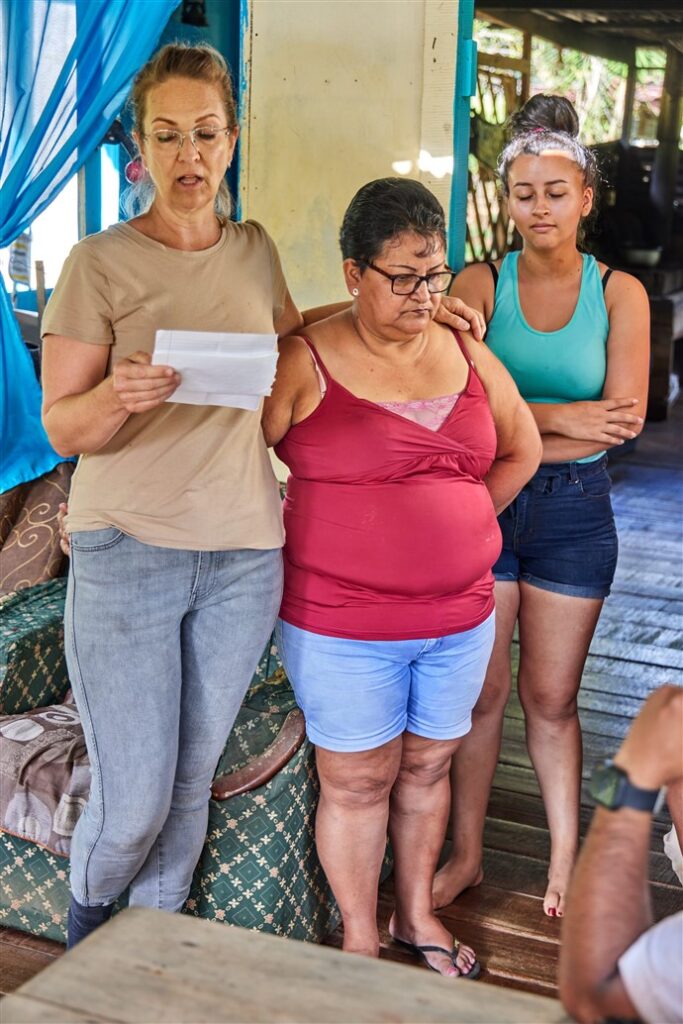
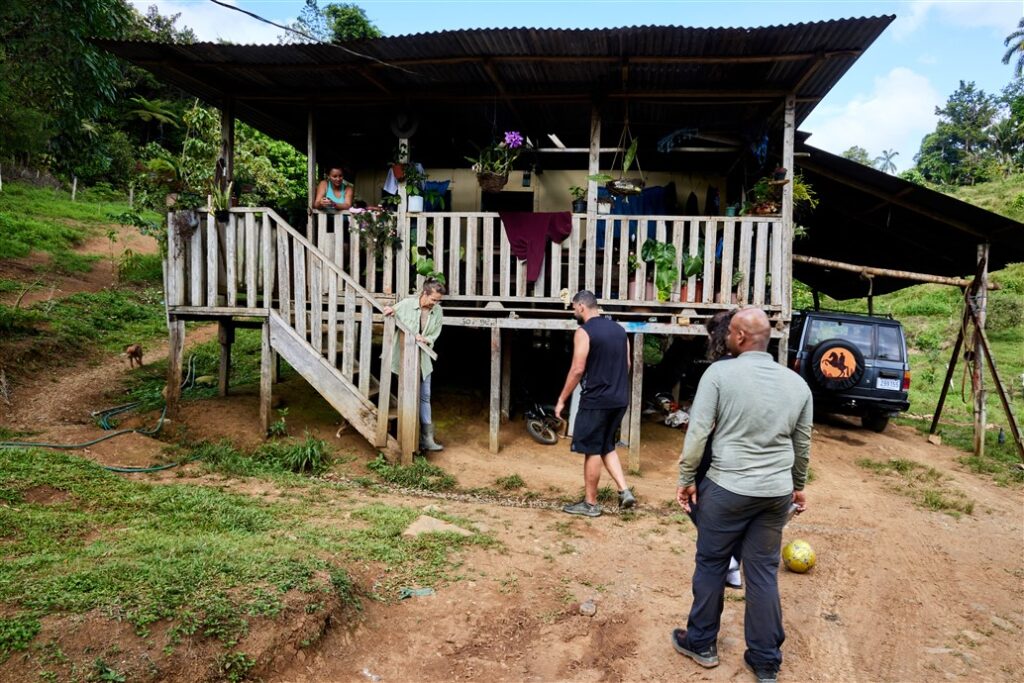
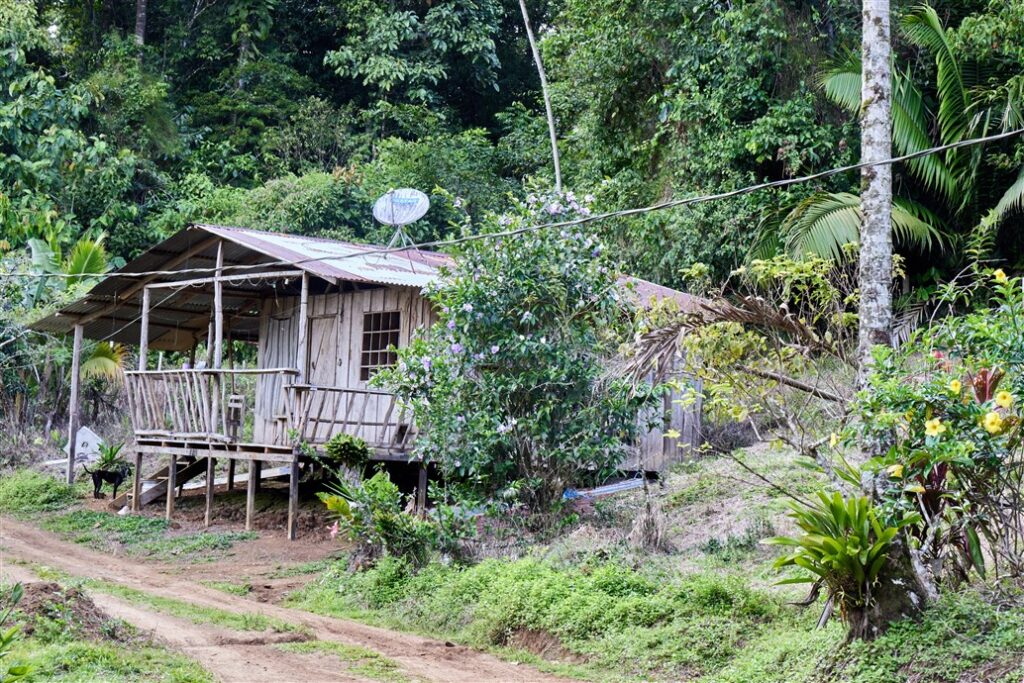
We took some photos, gave attention to some of the dogs, including one very friendly puppy, and then thanked all and walked back to the bus.
The air was much clearer than normal on our descent and, atop a hill overlooking Siquirres, Vicente pointed northeast and said that you could see all of the way to the Caribbean. You couldn’t quite see the beaches, but you could clearly see the atmospheric transition and very flat ground extending into the hazy distance.
We arrived at the hotel before 5pm and I reminded all that we were scheduled to depart for a special dinner at 6pm. It had been a busy day and all stumbled back to their hotel room showers.
Shortly before 6pm, I walked to the hotel entrance and met Don Marco who had arranged the dinner and transportation. The whole evening was to be paid for in cash and we had to order our meals in advance so that the restaurant could prepare the right amount of food. I thought that we were going to a conventional restaurant, but that was not to be the case.
By 6:15, the pre-arranged bus had not arrived. Marco grew increasingly agitated as he called the bus company. Finally, as we approached 6:30, he told me that he had canceled the bus and had called Vicente who had agreed to return to the hotel with his Edmoro Company bus and take us to dinner. The agreed price was 30,000 CRC and he arrived at 6:45. By now, everyone was ravenously hungry.
The drive to La Cucharra de Mire took about 10 minutes east along the Route 32 highway. When we arrived, we realized that we were the only guests for the evening. The restaurant was a combination home, kitchen, and event space. Colorfully dressed dancers in Caribbean-style costumes were dancing on a finished covered, concrete dance floor while what appeared to be friends and family looked on and a DJ spun very loud Caribbean music.
Jaime, the president of the Nari Awiri council had traveled with us for the meal and we were expected to meet with a reporter for a local media operation that was streaming the event on Facebook and maybe some others sites. We met the owner of the operation and the reporter and Marco explained the project to them and hung a flag emblem of the Mar a Mar Foundation and El Camino de Costa Rica on the wood-paneled wall behind the dance floor.
The team took seats around a very long table situated parallel to the dance floor front and immediately began interacting with the dancers and others. Devansh and Vaisali were dancing to the beat behind the table in the grass and Hana and others were joining the dancers on the floor.
After a couple of songs, the music was paused and the owner took a microphone and welcomed all of us. He then handed the mic to Marco who explained Mar a Mar and our DWC project to everyone, but especially for the benefit of the reporter that was using a selfie-stick-mounted cell phone to record his speech. Don Marco then passed the mic to Jaime who thanked all of us on behalf of the indigenous community. I followed with a few words thanking them all for their hospitality and warmth, reflecting what I thought were the feelings of the group.
Once complete, the music started again and our meals were served along with some tropical juice that tasted like a blend of guava and pineapple. A few of us had Imperial beer.
After we finished eating, including a small dessert, the dancing kicked into high gear. Some younger kids joined in as did all of the members of the team (except me–I chose to take photos), Marco, Jaime, and even our driver, Vicente. The fan favorite song of the night was “Rice and Beans,” a Costa Rican salsa number that consists of just repeating the words “Rice and Beans” about 300 times to varying tempo and accompaniment. Everyone seemed to have a genuinely fun time.


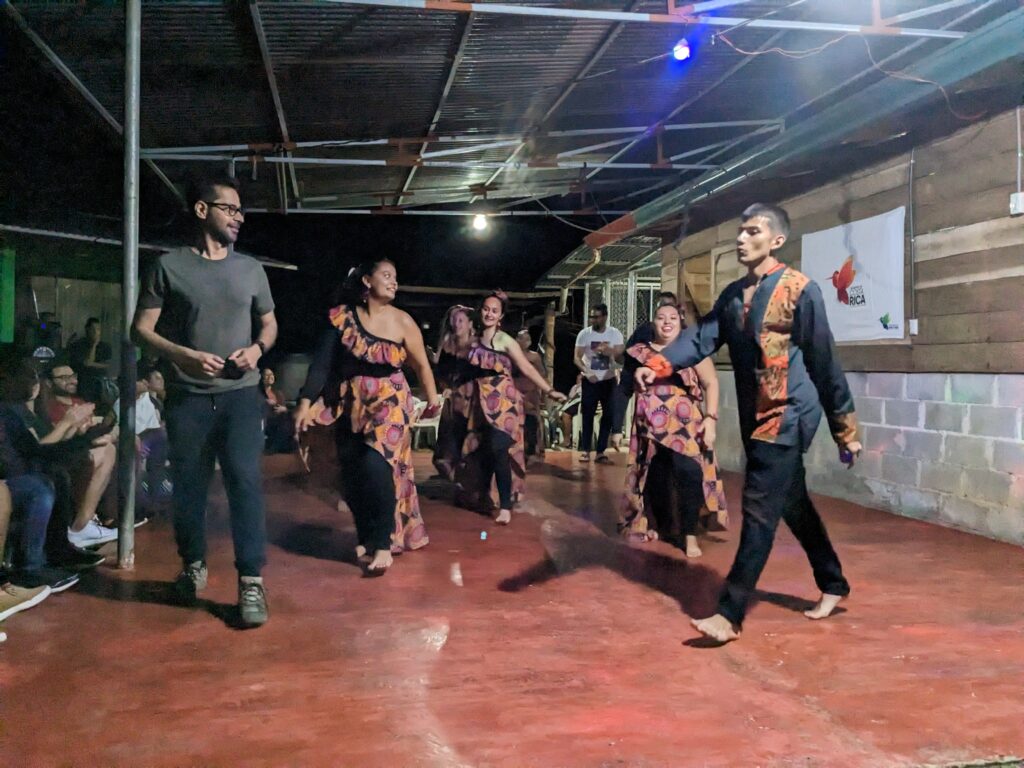
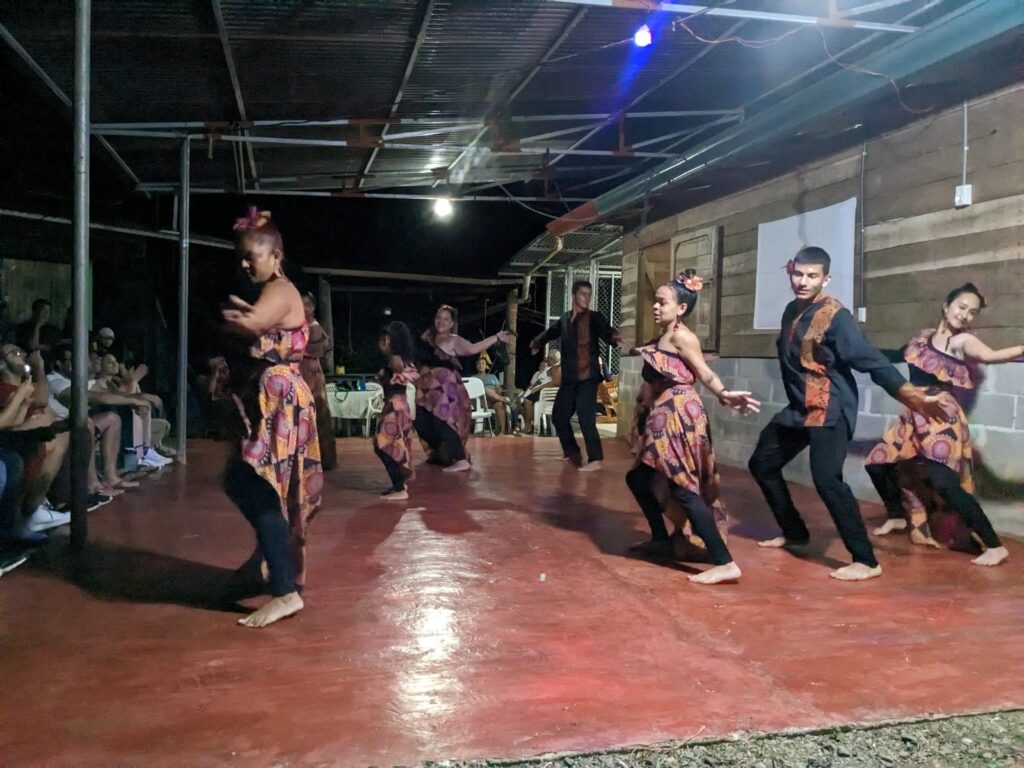
We left at 9:15pm and returned to the hotel, followed by another session around the pool. As this was our last night in Siquirres, conversation turned reflections on our week as well as plans of the future. I talked about future trips and DWC’s express intention to cultivate a long-term relationship with Salesforce.com and do more trips like this one. We talked about locations, time periods, lengths of trips, and all around the pool seemed incredibly positive about the possibility of another one-week trip a year from now to reunite the crew in a new location. I talked a lot about Cambodia and Tarek thought there or the Philippines would be wonderful places. Tarek was very keen to take on the role that Zohaib had performed for this project as the Salesforce point of contact and lead. I told them that, barring just a couple of select weeks over the next year, that, if they picked a location and dates, that I would sign up to be the DWC lead again.
I was very happy that it seemed we had accomplished one of our top trip goals–to build within the team members the desire to participate in and support future and on-going DWC projects.
I sent a WhatsApp message to joy reporting on our conversation and was surprised that she texted back almost immediately with word that if Tarek and Salesforce thought that they could put together a team to go to Cambodia in March 2024, that she would tentatively book it. She also said that the project would probably be helping to build a floating house for one of the seasonally floating villages along and within Tonle Sap–the large lake in the center of Cambodia. Tarek, Zohaib, and the others were very excited by the proposal. The evening ended on a very high note.

Friday 24 March 2023
Thursday evening, I explained to the team that we would be working for only about three hours Friday morning. We’d leave at the normal time, work largely without a long break through the morning, and then break for lunch at about 11:30am. From lunch, we’d go directly back to the hotel, shower, pack, and jump on another bus for our return to San Jose.
During breakfast time, I spent some time writing, then pre-packed a few things and checked with the hotel concerning any other additional charges. The young lady at the front desk told me that we would have to pay 5,000 CRC per room for late check-out, but when I told her that the late check-out had been negotiated into the contract, she quickly relented without me having to actually show her the contract.
After breakfast, we set a new standard in timeliness, leaving with the entire team by 7:32! It was another sunny day and probably even warmer than previous days. Maybe because it was the last day and we were so energized to finish as much work as possible, it seemed like the drive in took longer than normal.
Vaishali asked Carlos if she could take his seat in the front because she wanted to make a time lapse video of our drive in to remember it. She held her cell phone for over 30 minutes to document the steep hills, dense forest, and sometimes bone-rattling potholes and rocks.
When we arrived, Mariné met us at the entrance, as did about four more tons of gray pathway gravel. Hélène and her team took care of the rocks, adding to the depth of the previously completed paths. Others grabbed shovels and returned to the septic and leach pits to dig out as much as we could before quitting.
Carlos was laser-focused on getting the roof completed on the camping platform. We started by cleaning up the area–primarily taking the remnant concrete sheet pieces back to the thatch ranchero. When then delivered 12 four-by-eight-foot corrugated steel roof panels to the platform from the ranchero. The sheets were light, individually, but had sharp edges and we needed to use care not to cut ourselves.
While the roofing pieces were being carried down, Carlos arc welded the supporting cross beams onto the main roof beams. Next, we lifted the panels one at a time so Carlos could screw them into the main and cross beams. Hugo and Leo were helping Carlos do this, so moved to the digging and helped the team there. Zohaib, Daniel, and Prashant were working on the main pit, while Karthik and Deepak worked on the drainage area with me. We removed more large rocks and left a couple where they were. Attempting to pry one of the rocks loose with the pick axe, one of the handles snapped.
Above our work, the pathway team finished their work and several teammates came down to help dig. The rest of that team focused on cleaning the entire upper area, hosing down the kitchen area to remove all of the dirt and mud we’d tracked onto the concrete throughout the week. They also cleaned their tools and generally straightened up all of the material, remnants, and tools in the ranchero, per Carlos’s instructions.
By 11:15, Carlos was attaching the final roofing sheet with screws, having spent more than an hour scrambling atop the roof, sometimes lying flat and stretching to reach corners that needed to be secured with self-tapping screws–all supported by Jaime, Leo, Vicente, and Tarek. I asked the digging crew to cease work and begin carrying their tools up the hill to be cleaned and stored. We’d completed a little more than half of the septic tank digging (to a depth of about 1.20 meters) and well over half of the leach pit rectangle’s excavation.
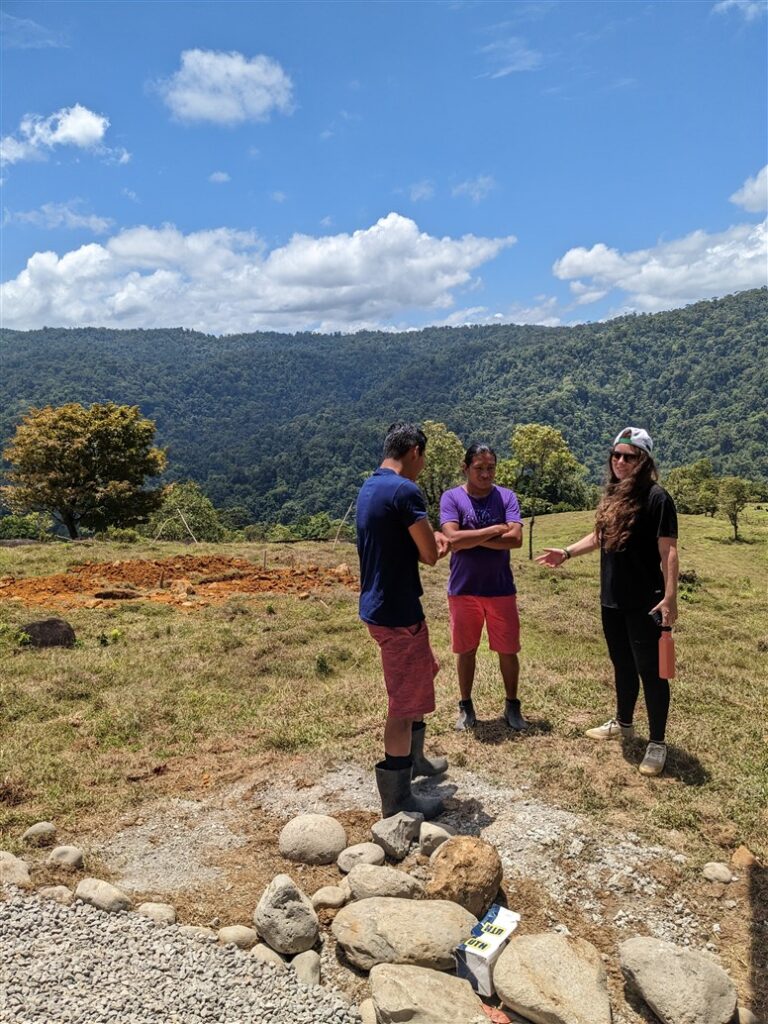
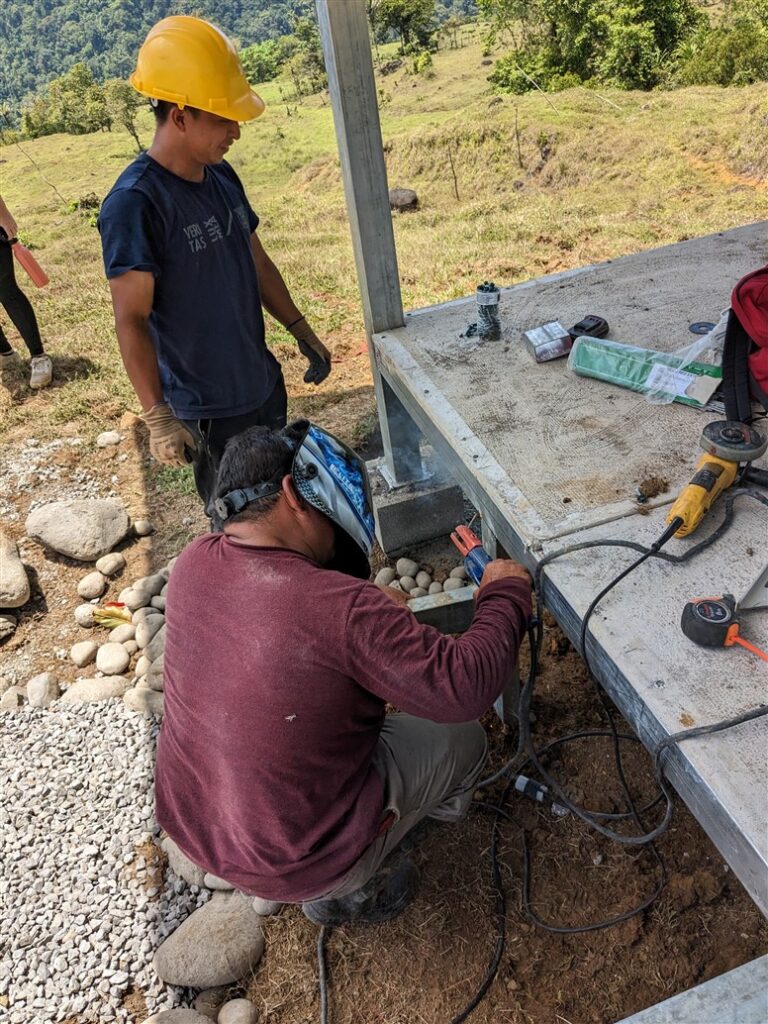
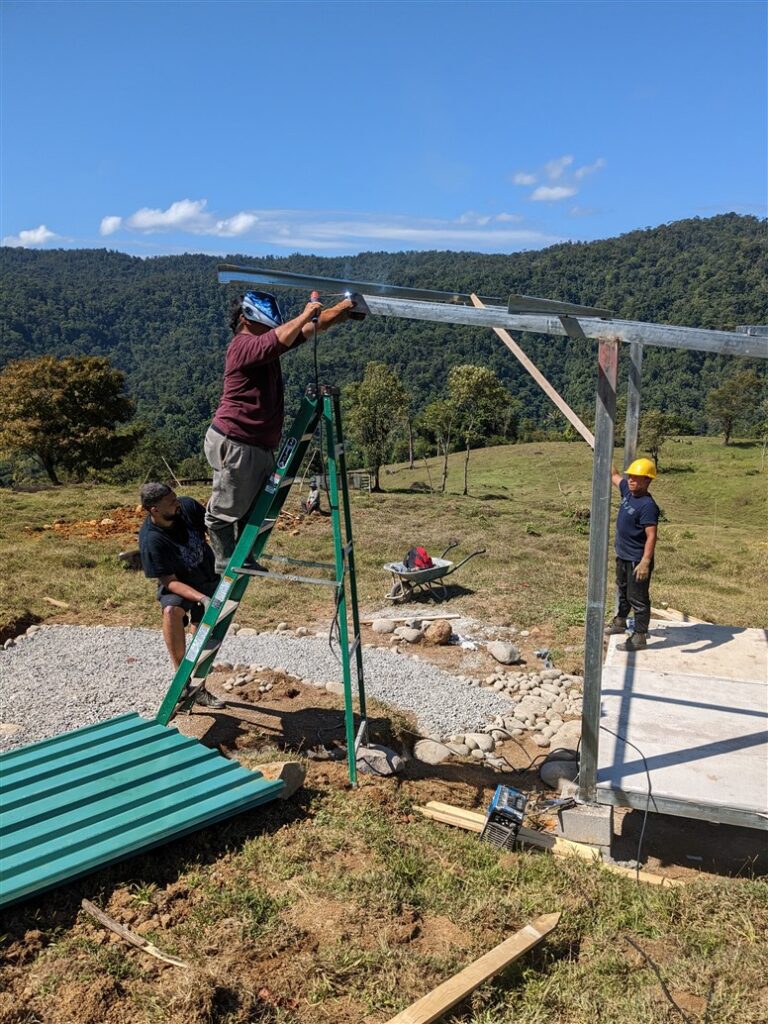
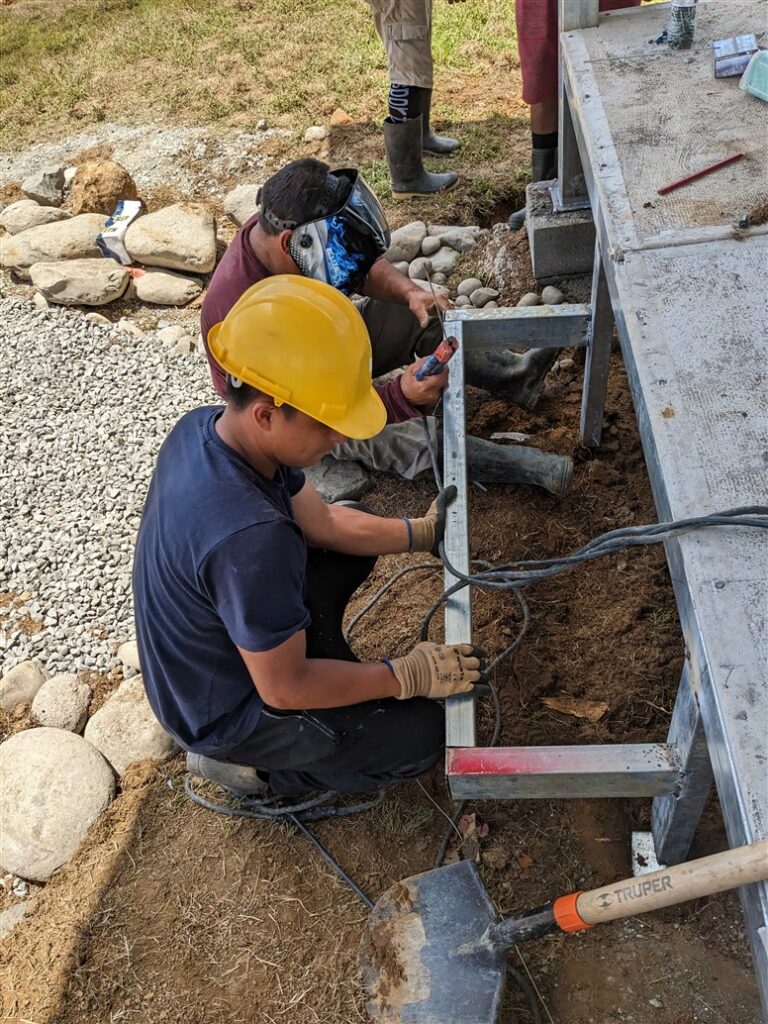
By now, the entire group was gathered around the camping platform and we took the opportunity to take group photos of the nearly finished project. Carlos and his team took a break for the photos, too, and then he told me that he wanted to complete the steel frame for the step up to the camping platform before we quit for the day (and week). We directed the team to head to lunch now that it was past 11:30 and I asked Mariné to package up takeaway bowls for Carlos, Vicente, and me so that we could do the step.
Carlos measured and I cut steel 2×4 pieces that formed a pair of “T’s” when welded together. Then, Carlos, with Hugo’s help, welded these pieces to the lower side of the platform base frame. The resulting step would be covered by a remnant piece of concrete sheet at some later date, but the work was finished for us.
We gathered up all of the electrical cables, tools, and scraps and began the final clean-up. Wooden stakes and twine were gathered from the digging area and Carlos hauled his arc welding transformer up the pathway for the last time this week. At the top, there was some final clean-up, but by the time that was completed the team was finished with lunch and returning to the kitchen area to gather their belongings and load the bus. I gave a personal tip to Vicente and my work gloves to Hugo. Earlier, I’d donated about a dozen T-shirts, some pairs of socks, and a new pair of rubber boots to Mariné who told me that she would distribute them to appropriately needy families. I asked her to give at least one of the Air Force Academy shirts to Hugo.
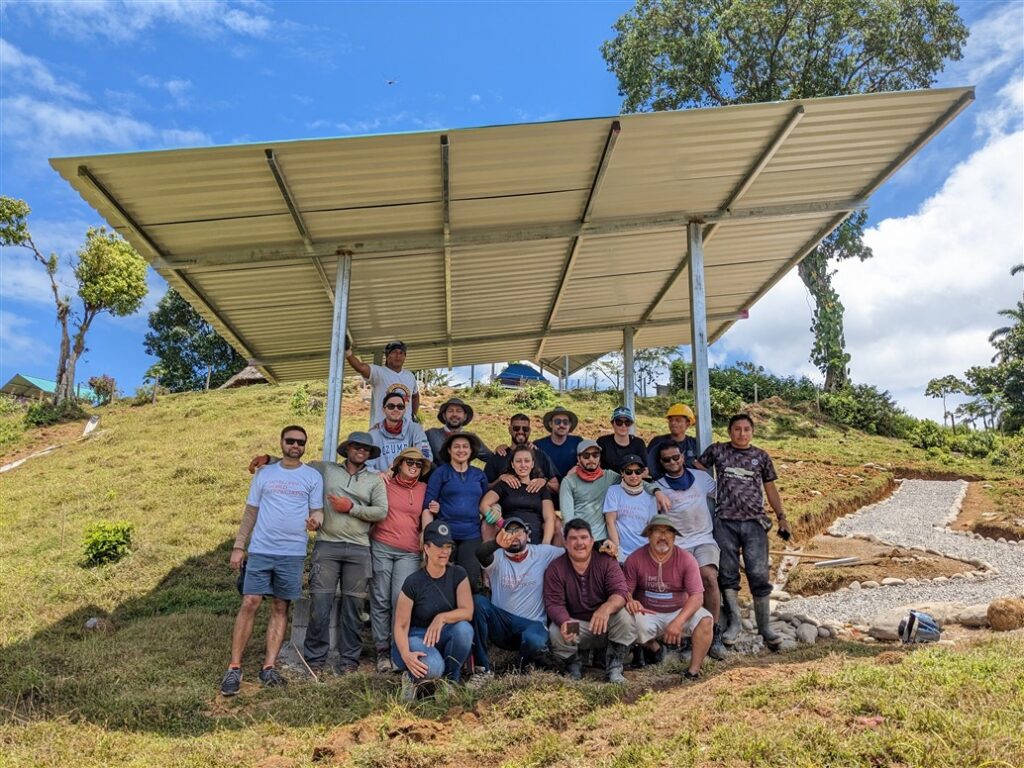
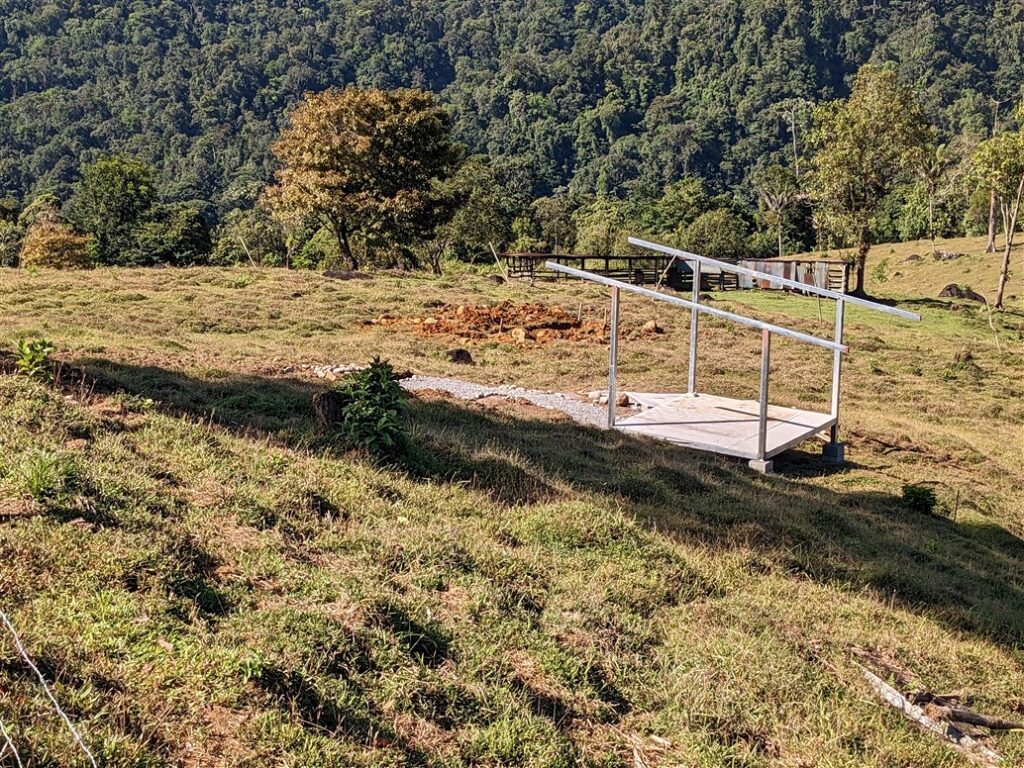
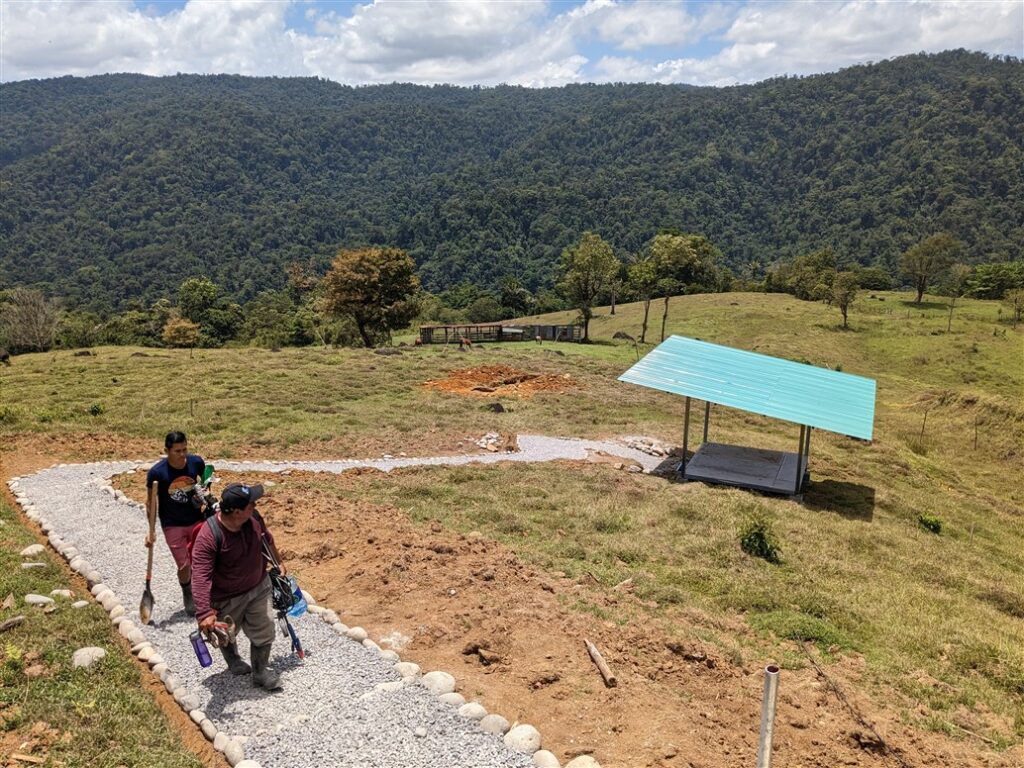

We gathered around the bus to say goodbye to Mariné and I gave her one of my camouflage Air Force logo hats and thanked her for all of her hard work. Others thanked her profusely and took another round of photos and selfies. We did a final goodbye on the bus with words from Zohaib and several others thanking the whole local team. I finished the session by presenting Carlos with another camouflage cap, this one adorned with one of my colonel’s eagles, thanking him for his leadership, instruction, and patience and acknowledging him as the “colonel of construction” at Tsinikicha. Both of us got a little too emotional with that goodbye.
We said final goodbyes at the hotel, returning at 1pm for our expected 2pm departure to return to San Jose. Everyone showered, finished packing, and we were on the bus by 2:10pm–not too bad, really!
The drive back to San Jose was very slow and traffic-plagued. We covered 78 kilometers in three hours, arriving at the Hotel Irazu at 5:15pm. On the bright side, the hotel was prepped for our return and already had our keys ready for us. We agreed to meet at 6:45 in the Holiday Inn lobby to coordinate Uber rides to the Costa Rica Beer Factory (CRBF) for a final celebratory dinner arranged by Marco. The Uber rides worked just fine and we all arrived within just a few minutes using four different cars.
The restaurant was full of beer- and alcohol-themed decorations as well as local crafts. We were seated in a side room around a single long table. Deepak started in with rum shots, while Daniel, Devansh, Prashant, and I had beer. Their IPA (hazy) was quite good. Karthik and others ordered mixed drinks.
Food ordering was chaotic to say the least. Tarek tried to order a few appetizers for the whole table, but it seemed that no one else heard him or understood his plan (though he’d clearly explained it), so most of the others ordered not only their own appetizers, but went straight to main courses. I just ordered another IPA and, eventually, a bowl of ceviche.
The food arrived in incoherent waves of appetizers and main courses, with a few having forgotten what they ordered–a condition not unrelated to the fact that, by now, some were on rum shot number three. We had WAY too much food, but it was good and no one went hungry.
As the eating slowed, Zohaib rose and spoke first about the entire trip in a very sincere, short speech. He then asked that we move around the group and each would say a few words, ending with me.


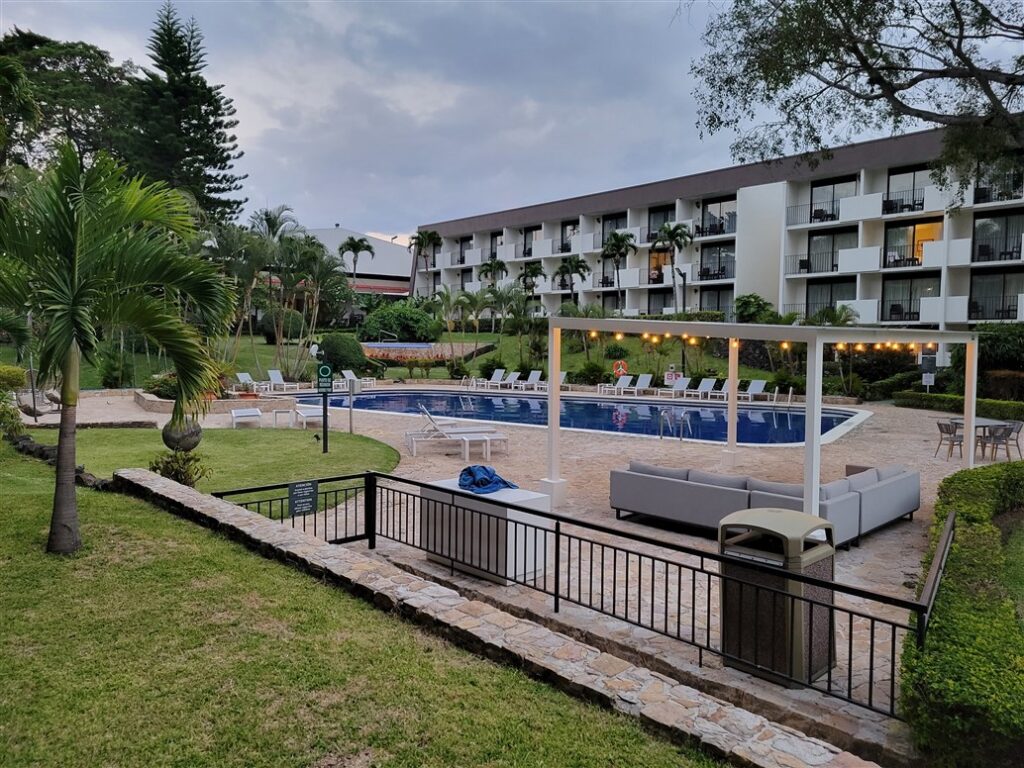
It was clear from the speeches that all had a great time on the trip and, more importantly, were very fulfilled by the hard work done and understanding gained. I concluded by thanking all of them for their courage and willingness to step outside of their comforts zones and give primarily of their time. I also thanked them (especially Zohaib) for making my job as team leader so easy. We concluded by all pledging to meet again for another project together and to stay in touch.
We Ubered back and some met in the Holiday Inn for a nightcap and more talk. By now it was 11pm and the four of us had only 3.5 hours before our van would leave for the airport, so I went to bed, managing to catch about two real hours of sleep.
Saturday 25 March 2023
Tarek, Hana, Hélène, and I jumped into the van with our luggage on schedule at 2:30am and made it to the airport in plenty of time for our 5:05, 5:35, and 6:35 departures, respectively. Kellie had the next taxi at 6:30 from hotel to airport and all of the others were planning to stay in Costa Rica for anywhere from a few days to two weeks of vacation.
I bought a venti latte at Starbucks after checking in, gave final goodbyes to the other three early morning travelers and sat down at a charging table to finish managing expenses and write. During the wait, Kellie updated me on her transportation and I sent a few notes.
I landed in Denver and scanned the many messages on WhatsApp from team members containing photos from the previous night, words of thanks, and future connections. I think that I’ll be writing another blog like this in about 12 months from Cambodia…
Posted in Costa Rica on March 22, 2023



